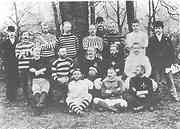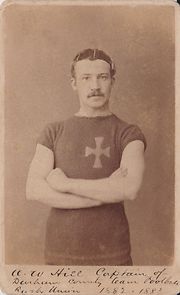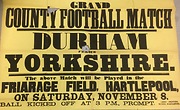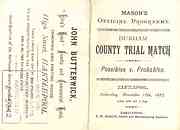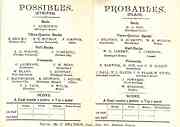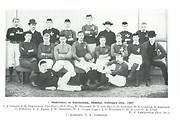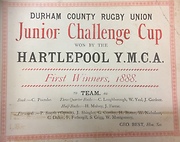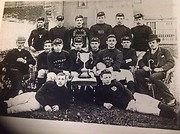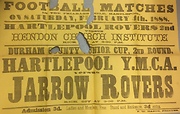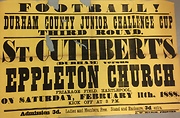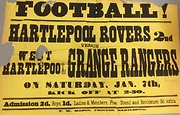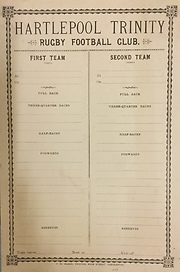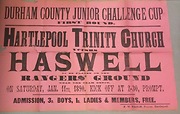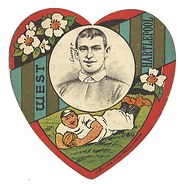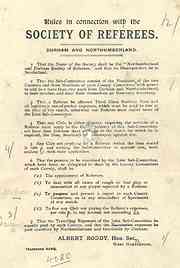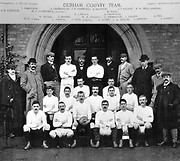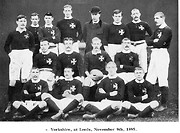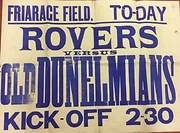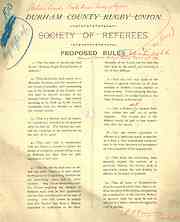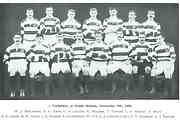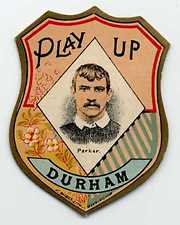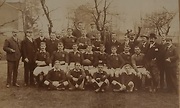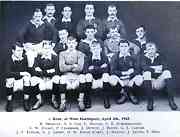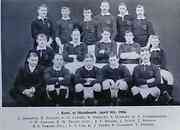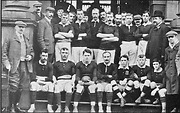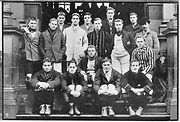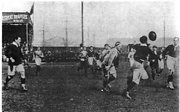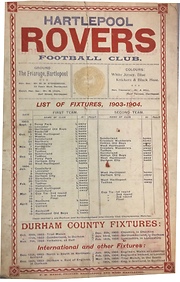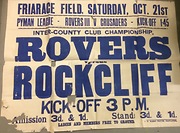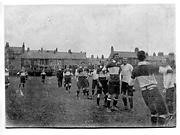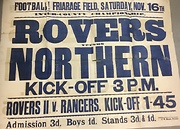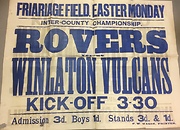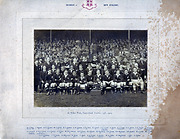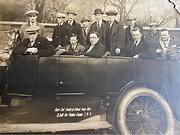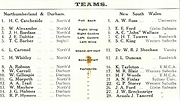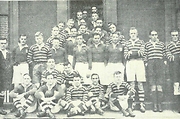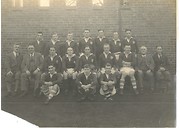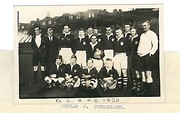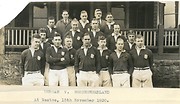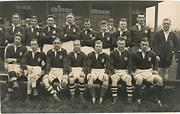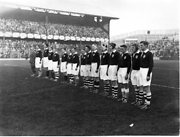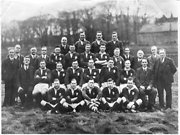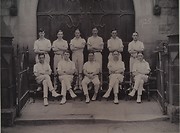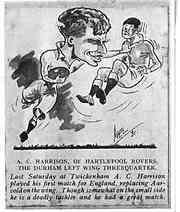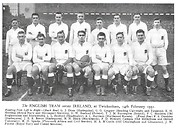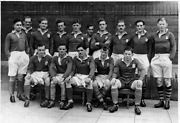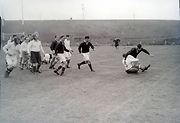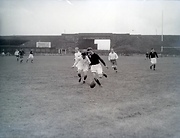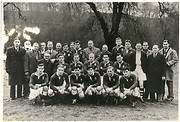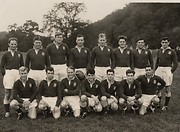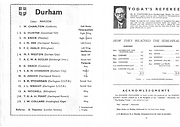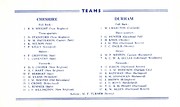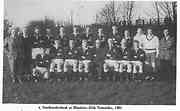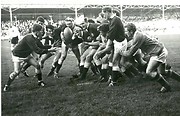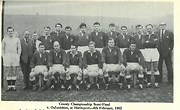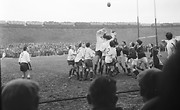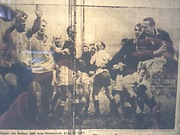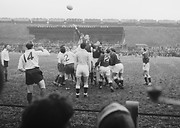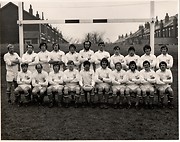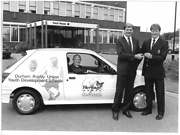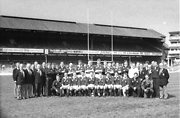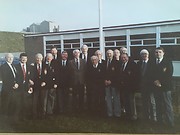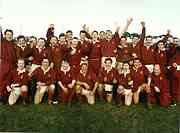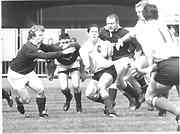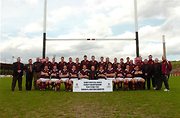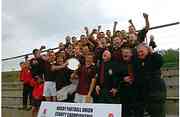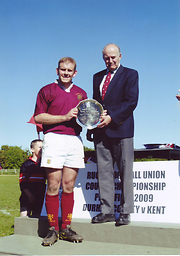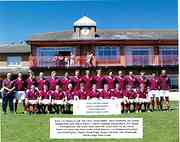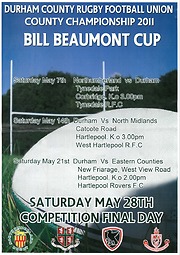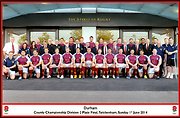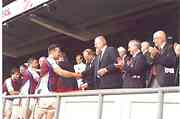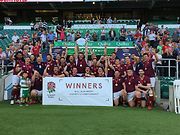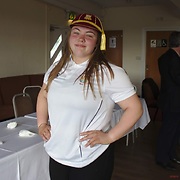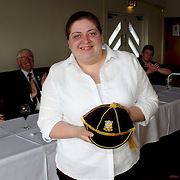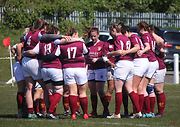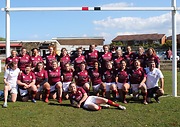 Hartlepool Sports & Leisure
Hartlepool Sports & Leisure
- Cinemas, Theatres & Dance Halls
- Musicians & Bands
- At the Seaside
- Parks & Gardens
- Caravans & Camping
- Sport
 Hartlepool Transport
Hartlepool Transport
- Airfields & Aircraft
- Railways
- Buses & Commercial Vehicles
- Cars & Motorbikes
- The Ferry
- Horse drawn vehicles
 A Potted History Of Hartlepool
A Potted History Of Hartlepool
- Unidentified images
- Sources of information
- Archaeology & Ancient History
- Local Government
- Printed Notices & Papers
- Aerial Photographs
- Events, Visitors & VIPs
 Hartlepool Trade & Industry
Hartlepool Trade & Industry
- Trade Fairs
- Local businesses
- Iron & Steel
- Shops & Shopping
- Fishing industry
- Farming & Rural Landscape
- Pubs, Clubs & Hotels
 Hartlepool Health & Education
Hartlepool Health & Education
- Schools & Colleges
- Hospitals & Workhouses
- Public Health & Utilities
- Ambulance Service
- Police Services
- Fire Services
 Hartlepool People
Hartlepool People
 Hartlepool Places
Hartlepool Places
 Hartlepool at War
Hartlepool at War
 Hartlepool Ships & Shipping
Hartlepool Ships & Shipping

Durham County RFU, its XVs and County Cups
Details about Durham County Rfu, Its Xvs And County Cups
Please go to button 1-9 for a chronological list of photographs and information relating to Durham County XVs and County Cups.
Location
Related items :
 1111 - the Senior Cup : History and Records
1111 - the Senior Cup : History and Records
The idea for a Durham Senior Cup came from the success of the Yorkshire Cup which had been introduced in 1877 and despite reservations by the R.F.U. it had proven very popular both on and off the field.
At a meeting held at the Three Tuns Hotel in Durham City in September of 1880, it was decided to introduce a Cup Competition among the Clubs which at that time comprised Sunderland, North Durham, Westoe, Houghton, Darlington, Durham [City], Bishop Auckland, Hartlepool and DurhamUniversity.
A sum of 50 guineas was agreed as the purchase price for the Cup, which is the one still being competed for among the Clubs, and Hartlepool Football Club holds the honour of being the first local club to play in the draw. They were drawn away to Sunderland Rovers in the preliminary Round on the 8th January 1881 and were defeated by one goal and one try to Nil! The balance has been redressed on many occasions since then. The draw in the first season ran as follows : -
| Round 1 | |||||||
| HOME TEAM | GOALS | TRIES | MINORS | AWAY TEAM | GOALS | TRIES | MINORS |
| Sunderland Rovers | 1 | 1 | 0 | Hartlepool | 0 | 0 | 0 |
| Round 2 | |||||||
| Houghton | 0 | 1 | 3 | North Durham | 0 | 0 | 0 |
| Darlington | 3 | 0 | 4 | Durham City | 0 | 0 | 3 |
| Sunderland | W/O | Durham University | |||||
| Westoe | W/O | Bishop Auckland | |||||
| Round 3 | |||||||
| Darlington | 0 | 0 | 0 | Sunderland | 1 | 1 | 0 |
| Houghton | 1 | 0 | 5 | Westoe | 0 | 0 | 3 |
| (Match played at Sunderland RFC, Chester Road, Cricket Ground, Sunderland) | |||||||
| Sunderland Rovers | BYE | ||||||
| Semi finals | |||||||
| Houghton | 2 | 0 | 9 | Sunderland Rovers | 0 | 0 | 0 |
| Sunderland | BYE | ||||||
| Final | |||||||
| WINNERS | GOALS | TRIES | MINORS | RUNNERS-UP | GOALS | TRIES | MINORS |
| Sunderland | 0 | 3 | 2 | Houghton | 0 | 0 | 1 |
 1112 - The Intermediate Cup : Records and History
1112 - The Intermediate Cup : Records and History
The introduction of Leagues into Rugby had a profound effect on the Knockout Competitions within the County, resulting in smaller Club Groups based on current League status. This in turn created a demand for another Competition between the former “Senior” and “Junior” Cups. In consequence, the County introduced the “Immediate Cup for Competition in 2001-02 season, which also happened to be the 125th Anniversary of the founding of the County Union in 1876.
| 2001-02 | Horden | 41 | Billingham | 23 |
| 2002-03 | Consett & District awarded Cup | Hartlepool could not agree date | ||
| 2003-04 | Durham City | 34 | Billingham | 13 |
| 2004-05 | Durham City | 16 | Billingham | 15 |
| 2005-06 | Durham City | 16 | Consett & District | 13 |
| 2006-07 | Durham City | 24 | Gateshead | 13 |
| 2007-08 | Billingham | 14 | Hartlepool Rovers | 7 |
| 2008-09 | Sususpended until 2009-10 | |||
| 2009-10 | Merged with Senior Cup pro tem | |||
| 2010-11 | Stockton | 20 | Gateshead | 16 |
| 2011-12 | Darlington | 47 | Stockton | 17 |
| 2012-13 | Consett & District | 31 | Hartlepool Rovers | 20 |
| 2013-14 | Consett & District | 31 | Hartlepool Rovers | 29 |
| 2014-15 | Durham City | 20 | Hartlepool Rovers | 7 |
| 2015-16 | Gateshead | 44 | Hartlepool Rovers | 20 |
| 2016-17 | Gateshead | 18 | Barnard Castle | 14 |
| 2017-18 | Barnard Castle | 29 | South Shields Westoe | 20 |
| 2018-19 | Durham City | 43 | South Shields Westoe | 17 |
| 2019-20 | Competition cancelled | due to Covid Epedemic | ||
| 2020-21 | Competition cancelled | due to Covid Epedemic |
2021-22 Consett & District 50 Hartlepool Rovers 23
2022-23 Sunderland 25 Ryton 10
2023-24 Hartlepool 29 Hartlepool Rovers 28
2024-25
Plate Hartlepool Rovers 39 Westoe 19
More detail » 1113 - The Junior Cup: History & Records
1113 - The Junior Cup: History & Records
The Junior Cup was first put up for Competition in 1887 – 1888 season and after over a 130 years of service, the original Cup has been replaced in 2021 with a new trophy. It was played for initially by the 1st XVs of clubs which had not at any time been members of the County Union. A condition of winning the Cup was that the winners must apply for admission to the Union and would not be classed as “Junior”. The arrival of the Competition was welcomed by the then Junior Clubs who generally were in a lethargic state but pressing for change in the Rugby Union locally.
The first decade of the competition matches were not settled by points but by Goals, tries and Minors and it were not until 1897 that a point’s only decision would be agreed on. The rule to enforce cup winners becoming Senior Clubs,was counterproductive and amended in 1895 to allow winners to enter in the 2nd Teams Cup and apply for Senior Status if they won.
Some information is missing although research is ongoing to complete the record, any information you may have would be appreciated, please email to chrismcl@btinternet.com with details.
Geographic and History note.
The Game has been played in many areas of Durham by many now largely forgotten clubs/teams, and the only evidence of their existence is on the cup plinth or faded photographs and in newspaper files. Readers will like to know the whereabouts or background to some of the clubs as follows:-
Blackhill: part of Consett District and a fore runner of the present Consett & District club.
Bensham: a Gateshead club and fore runner of the present Gateshead club, there was a earlier Bensham founded in 1876 which was absorbed into the North Durham RFC (1876-1998).
Chopwell: from N W Durham,formed in 1909 by City & England player Harry Imrie & N C Nielson from Sunderland RFC. The club restarted in 1925 but ceased around 1927.
Empress Rovers: a Pyman League club from Hartlepool named after a theatre in Northgate!
Furness Athletic: based in Haverton Hill on the Furness shipyard.
Greenside : A colliery based club from near Ryton
Henderson’s Creelers: a factory side that played on Factory Field, Durham City,on what is now the Swimming Baths at Elvet Bridge. Hendersons was a carpet factory taken over as Hugh Mackay in 1905. They went defunct in 1894, presumably not wanting to be a Senior Club.
Heortensians: a Pyman League side from Hartlepool, name taken from one of a number of ancient spelling of the name of the District around Hartlepool.
Houghton Nomads. Formed in 1895 and played at Copt Hill, Houghton, they won the Cup in 1900 and reported defunct by June 1901.
Mount Pleasant: one of several clubs in the Gateshead area, folded in 1894 as they had no ground to play on, probably did not want to be a Senior CLub
Old Bedans: the former pupils of Bede G.S. Sunderland, folded in 1964
Seamen's Institute: from Hartlepool, based at the Mission Hall on the Town Wall,which still stands as a private dwelling.
Sherburn House: a colliery side, east of Durham City, based on Sherburn Colliery.
Sleetburn: a colliery side, west of Durham City, based on New Brancepeth, played at Pringle House.
South Shields St Pauls - One of the many junior clubs based in Shields and Jarrow. They joined the original Rugby League in 1901, one of only two Durham clubs to do so.
South Shields 4th Durham Howitzer Battery (played on the toughest pitch, probably, in the country – at Trow Rocks, which had minimal top soil cover – if any!)
Southwick Rangers: a Sunderland Club.
Stargate (Rovers) : a colliery side in Ryton/Blaydon.played at Holly Bush.
Stranton Vulcans: a Pyman League side from West Hartlepool played at Foggy Furze, probably New Stranton Celtic under a new name, they lasted only two seasons.
Throston Wanderers: a "Old" Hartlepool side, one of several Throston Township Clubs
* G.T.M. in the list below refers to goals, tries and Minors. A goal was when the ball went over the bar between the posts, Try for a touchdown, you were allowed to try for goal! and a minor occurred when for instance, your opposition conceded a five metre scrum on your own line, similar to conceding a corner in soccer!
|
Season |
Winner |
*G.T.M. |
Runners Up |
*G.T.M. |
Venue |
|
1887/88 |
Hartlepool Y.M.C.A. |
1 |
St.Cuthberts Durham |
nil |
Hendon Parish Church |
|
1888/89 |
Throston Wanderers |
2.2.4. |
Sherburn House |
0.0.1. |
Victoria Grnd West Hartlepool |
|
1889/90 |
South Shields Y.M.C.A |
1.0.2. |
West Hartlepool West End |
0.0.6. |
Holy Drift Durham |
|
1890/91 |
West Hartlepool West End |
1.0.4. |
South Shields Holy Trinity |
0.1.1. |
Ashbrooke |
|
1891/92 |
Sherburn House |
1.2.0. |
South Shields Holy Trinity |
0.3.0. |
Ashbrooke |
|
1892/93 |
Mount Pleasant |
1.0.0. |
Henderson’s Creelers |
0.0.0. |
Ashbrooke |
|
1893/94 |
Henderson’s Creelers |
2.1.0. |
Hartlepool Wanderers |
0.0.0. |
Park Rd Jarrow |
|
1894/95 |
Hartlepool Old Boys |
2.1.0. |
Sleetburn |
0.0.0. |
Park House, Sherburn |
|
1895/96 |
Spennymoor Park Rovers |
3.1.0 |
West Hartlepool Vulcans |
0.0.0. |
Dairy Lane Houghton |
|
1896/97 |
West Hartlepool Vulcans |
1.3.0. |
Stargate |
1.0.0. |
Boldon |
|
1897/98 |
South Shields St Pauls |
10 pts |
West Hartlepool Hornets |
0 pts |
Houghton a.e.t. |
|
1898/99 |
Sleetburn United |
11 |
Boldon |
0 |
Houghton |
|
1899/00 |
Houghton Nomads |
15 |
Boldon |
0
|
Hollow Drift a.e.t. |
|
1900/01 |
Boldon |
13 |
West Cornforth Rovers |
3 |
Hollow Drift after a 3 all draw & a,e,t, on Ashbooke |
|
1901/02 |
Empress Rovers |
6 |
Hetton O.B. |
3 |
Hollow Drift |
|
1902/03 |
Hetton O.B. |
6 |
Croxdale Wanderers |
0 |
Hollow Drift a.e.t. |
|
1903/04 |
Winlaton Vulcans |
8 |
West H'pool Nomads |
0 |
Hollow Drift |
|
1904/05 |
Blaydon Wanderers |
6 |
Hartlepool Crusaders |
4 |
Westoe |
|
1905/06 |
Hartlepool Rangers |
6 |
West Crusaders |
4 |
The Friarage |
|
1906/07 |
Stranton Vulcans |
7 |
Gilesgate |
0 |
Ashbrooke |
|
1907/08 |
Hartlepool Rangers |
8 |
Gilesgate |
3 |
The Friarage |
|
1908/09 |
Greatham |
10 |
Ryton |
8 |
Ashbrooke a.e.t. |
|
1909/10 |
Ryton |
3 |
Tudhoe & Ferryhill United |
0 |
Ashbrooke a.e.t. |
|
1910/11 |
Chopwell |
11 |
Shields 4th Howitzers |
0 |
Winlaton |
|
1911/12 |
Hartlepool Red Rose |
6 |
Hartlepool Nomads |
0 |
The Friarage |
|
1912/13 |
Southwick Rangers |
14 |
Blackhill & District |
0 |
Westoe |
|
1913/14 |
Bensham |
9 |
Blackhill & District |
3 |
Blaydon Haughs a.e.t. |
|
1914/15 to 1921/22 Competition suspended owing to the Great War |
|||||
|
1921/22 |
Greenside |
11 |
Furness Athletic |
3 |
The Friarage |
|
1922/23 |
Throston Wanderers |
8 |
Hartlepool Red Rose |
6 |
The Friarage |
|
1923/24 |
Hartlepool Red Rose |
14 |
Heortensians |
5 |
Clarence Road |
|
1924/25 |
Heortensians |
8 |
Furness Athletic |
0 |
The Friarage |
|
1925/26 |
Seamen’s Institute |
26 |
Chopwell |
3 |
Westoe |
|
1926/27 |
Consett & District |
4 |
Horden |
3 |
Stella Blaydon |
|
1927/28 |
Darlington Railway Athletic |
8 |
Billingham |
0 |
Clarence Road |
|
1928/29 |
Horden |
3 |
Southwick Rangers |
0 |
Clarence Road |
|
1929/30 to 1933/34 Competition suspended |
|||||
|
1933/34 |
Winlaton Vulcans |
8 |
West Hartlepool S.S.O.B. |
3 |
North Durham |
|
1934/35 |
Sunderland Hornets |
8 |
West Hartlepool E.R.O.B. |
0 |
Houghton |
|
1935/36 |
West Hartlepool E.R.O.B. |
12 |
Hartlepool B.B.O.B. |
6 |
Clarence Road |
|
1936/37 |
Hartlepool B.B.O.B. |
15 |
Sunderland Rovers |
0 |
Clarence Road |
|
1937/38 |
Southwick Rangers |
3 |
Reyrolles |
0 |
Gateshead Fell |
|
1938/39 |
Reyrolles |
11 |
Sunderland Rovers |
0 |
Ashbrooke |
|
1939/40 to 1947/48 Competition suspended due to Second World War |
|||||
|
1947/48 |
Darlington G.S.O.B. |
11 |
Winlaton Vulcans |
4 |
Hollow Drift after a 3 all draw at Houghton |
|
1948/49 |
Winlaton Vulcans |
21 |
Bede College |
3 |
|
|
1949/50 |
Bede College |
|
Sunderland Technical College |
|
|
|
1950/51 |
West Hartlepool G.S.O.B. |
6 |
South Shields Marine School |
0 |
Houghton |
|
1951/52 |
Old Bedans |
6 |
South Shields Marine School |
0 |
Ashbrooke |
|
1952/53 Competition suspended |
|||||
|
1953/54 |
Bede College |
15 |
Old Bedans |
0 |
Durham |
|
1954/55 |
Old Bedans |
6 |
Bede College |
3 |
West Hartlepool |
|
1955/56 |
Old Bedans |
21 |
West Hartlepool G.S.O.B. |
0 |
Stockton |
|
1956/57 |
Old Bedans |
25 |
Horden |
6 |
Durham City |
|
1957/58 |
Bede College |
14 |
Hartlepool B.B.O.B. |
0 |
New Friarage |
|
1958/59 |
Bede College |
13 |
West Hartlepool G.S.O.B. |
3 |
Billingham |
|
1959/60 |
West Hartlepool G.S.O.B. |
16 |
Horden |
11 |
Horden |
|
1960/61 |
Horden |
14 |
Bede College |
10 |
North Durham |
|
1961/62 |
Horden |
11 |
Bede College |
8 |
The Friarage |
|
1962/63 |
Horden |
3 |
West Hartlepool G.S.O.B. |
0 |
Clarence Road |
|
1963/64 |
Winlaton Vulcans |
|
West Hartlepool G.S.O.B. |
|
Horden |
|
1964/65 |
West Hartlepool G.S.O.B. |
17 |
West Hartlepool T.D.S.O.B. |
6 |
Grayfields,West Hartlepool |
|
1965/66 |
Winlaton Vulcans |
21 |
West Hartlepool T.D.S.O.B. |
3 |
Durham City |
|
1966/67 |
Durham Constabulary |
14 |
Bede College |
5 |
Durham City |
|
1967/68 |
Bede College |
8 |
Durham Constabulary |
5 |
Stockton |
|
1968/69 |
Sunderland College of Education |
8 |
Readheads |
3 |
Westoe |
|
1969/70 |
Bede College |
17 |
West Hartlepool T.D.S.O.B. |
0
|
Grayfields,Hartlepool after 9 all draw at Maiden Castle |
|
1970/71 |
West Hartlepool T.D.S.O.B. |
3 |
Readheads |
0 |
Durham City |
|
1971/72 |
Sunderland College of Education |
12 |
Readheads |
3 |
Oakleigh Gardens South Shields |
|
1972/73 |
Hartlepool B.B.O.B. |
16 |
Readheads |
9 |
Mayfield Park |
|
1973/74 |
Hartlepool B.B.O.B. |
16 |
Readheads |
4 |
Marine School |
|
1974/75 |
West Hartlepool T.D.S.O.B. |
13 |
Hartlepool B.B.O.B. |
9 |
Mayfield Park |
|
1975/76 |
Bede College |
8 |
West Hartlepool T.D.S.O.B. |
3 |
Mowden Park |
|
1976/77 |
Hartlepool B.B.O.B. |
15 |
Bede College |
4 |
Brierton Lane, after a 6 all draw at Aycliffe |
|
1977/78 |
Hartlepool B.B.O.B. |
15 |
Bede College |
4 |
Ashbrooke |
|
1978/79 |
Darlington Railway Athletic |
9 |
West Hartlepool T.D.S.O.B. |
3 |
Stockton |
|
1979/80 |
Belford House |
22 |
Hartlepool B.B.O.B. |
3 |
Durham City |
|
1980/81 |
Hartlepool B.B.O.B. |
9 |
Belford House |
3 |
Darlington |
|
1981/82 |
Belford House |
9 |
Hartlepool B.B.O.B. |
6 |
Ryton |
|
1982/83 |
Hartlepool B.B.O.B. |
15 |
Belford House |
10 |
Blaydon |
|
1983/84 |
Hartlepool B.B.O.B. |
18 |
Belford House |
13 |
Stockton |
|
1984/85 |
Seaham |
12 |
Hartlepool B.B.O.B. |
9 |
Winlaton |
|
1985/86 |
Seaham |
12 |
Bishop Auckland |
7 |
Mayfield Park |
|
1986/87 |
Seaham |
29 |
Bishop Auckland |
0 |
Grayfields |
With the adoption of the League system in 1986/87 and the abandonment of the two-tier membership system in Durham County, the Junior Cup was used as the Challenge Trophy until the beginning of the new century but reverted to the Junior Cup after a few seasons.
|
1987/88 |
Bishop Auckland |
14 |
Seaham |
9 |
Hollow Drift |
|
1988/89 |
Hartlepool |
7 |
West Hartlepool T.D.S.O.B. |
6 |
Mayfield Park |
|
1989/90 |
Consett & District |
12 |
Houghton |
4 |
Hollow Drift |
|
1990/91 |
Darlington |
13 |
West Hartlepool T.D.S.O.B. |
0 |
Stockton |
|
1991/92 |
Seaham |
8 |
Billingham |
3 |
New Friarage |
|
1992/93 |
West Hartlepool T.D.S.O.B. |
43 |
Houghton |
24 |
Mayfield Park |
|
1993/94 |
Seaham |
8 |
Chester le Street |
0 |
Mayfield Park |
|
1994/95 |
Bishop Auckland |
25 |
Darlington Railway Athletic |
22 |
New Friarage |
|
1995/96 |
North Durham |
14 |
South Tyneside College |
12 |
North Durham |
|
1996/97 |
Billingham |
15 |
Houghton |
5 |
Hollow Drift |
|
1997/98 |
Houghton |
11 |
Consett & District |
0 |
Hollow Drift |
|
1998/99 |
Billingham |
23 |
Bishop Auckland |
17 |
Hollow Drift |
|
1999/00 |
Hartlepool |
29 |
Seaton Carew |
0 |
Seaton Carew |
|
2000/01 |
Hartlepool |
33 |
Seaton Carew |
21 |
Mayfield Park |
|
2001/02 |
Hartlepool |
26 |
Seaton Carew |
14 |
Seaton Carew |
|
2002/03 |
Houghton |
7 |
Seaton Carew |
6 |
Mayfield Park |
|
2003/04 |
Sunderland |
16 |
Winlaton Vulcans |
6 |
Hollow Drift |
|
2004/05 |
Sunderland |
67 |
Seaton Carew |
7 |
Hollow Drift |
|
2005/06 |
Sunderland |
43 |
Bishop Auckland |
0 |
Grayfields |
|
2006/07 |
Ryton |
17 |
Sunderland |
13 |
Gateshead |
|
2007/08 |
Stockton |
35 |
Barnard Castle |
13 |
New Friarage |
|
2008/09 |
Ryton |
20 |
Barnard Castle |
9 |
Houghton |
|
2009/10 |
Sunderland |
46 |
Barnard Castle |
24 |
|
|
2010/11 |
Bishop Auckland |
30 |
Barnard Castle |
24 |
Catcote Road |
|
2011/12 |
Winlaton Vulcans |
15 |
Bishop Auckland |
6 |
Hollow Drift |
|
2012/13 |
Bishop Auckland |
34 |
Seaham |
10 |
Grayfields |
|
2013/14 |
Barnard Castle |
16 |
Hartlepool B.B.O.B. |
15 |
Hollow Drift |
|
2014/15 |
Barnard Castle |
35 |
Houghton |
13 |
Hollow Drift |
|
2015/16 |
Barnard Castle |
40 |
Winlaton Vulcans |
14 |
Darlington |
|
2016/17 |
Bishop Auckland |
34 |
Winlaton Vulcans |
29 |
Consett |
|
2017/18 2018/19 2019/20 2020/21 2021/22 2022/23 2023/24 2024/25 Plate |
Sunderland Ryton Sunderland No comp B. Auckland Seaham Darlington Seaham Hartlepool BBOB |
20 28 27
22 32 39 28 34 |
Ryton Winlaton V Winlaton V
Darlington Houghton DMP Elizabethans Yarm Newton Aycliffe |
18 18 21
21 10 22 24 26 |
Durham City Durham City Gateshead
Darlington Dairy Lane Hollow Drift Leisure Cen Seaham Old Friarage Field Hpl
|
Researched and written by Chris McLoughlin, Hon. Sec. of the Hartlepool & District R.F.U. and Past President & Sec. of Durham County R.F.U.,and Mr John Davison, Gateshead RFC - Durham County R.F.U.
More detail »
 1114 - The County Plate : Records and History.
1114 - The County Plate : Records and History.
The County Plate : Records and History. The newest of the Adult Competitions, first put up in 2006/07
| 2006-07 | South Tyneside College | 32 | Seaham | 8 |
| 2007-8 | South Tyneside College | 34 | Seaham | 3 |
| 2008-09 | Seaham | 22 | Chester le Street | 16 |
| 2009-10 | Chester le Street | 27 | Newton Aycliffe | 0 |
| 2010-11 | Newton Aycliffe | 18 | South Tyneside College | 15 |
| 2011-12 | Seaham | 25 | Newton Aycliffe | 0 |
| 2012-13 | Hartlepool B.B.O.B. | 34 | South Tyneside College | 17 |
| 2013-14 | Newton Aycliffe | 54 | Washington | 12 |
| 2014-15 | Yarm | 20 | Chester le Street | 15 |
| 2015-16 | Sedgefield | 20 | Chester le Street | 5 |
| 2016-17 | Chester le Street | 24 | West Hartlepool T.D.S.O.B. | 10 |
| 2017-18 | Houghton | 30 | South Shields | 15 |
| 2018-19 | Houghton | 10 | Yarm | 6 |
| 2019 21 | competition cancelled | due Cov Epedemic | ||
| 2021-22 | Houghton | 20 | Darlington MP Elizabethans | 12 |
| 2022-23 | 2023-24 | No Competition. | ||
 1115 - The Second Teams Cup : History and Records
1115 - The Second Teams Cup : History and Records
Following on from the runaway success of the Senior Cup, a competition for the 2nd XVs was set up in the season of 1887/88, this was the same season that the County Junior Cup was inaugurated, that being for the 1st XV of Clubs that had not held membership of the Union.
| Season | Winners | g.t.m. | Runners Up | g.t.m. |
| 1887-88 | Tudhoe | 2.0.5 | Houghton | 0 |
|
1888-89 |
Hartlepool Rovers | 2.0.2. | Tudhoe | 0 |
|
1889-90 |
Hartlepool Rovers | 5.1.0. | Houghton | 1.1.0 |
|
1890-91 |
Hartlepool Rangers | 1.2.5. | Durham City | 1.2.0. |
| 1891-92 | Tudhoe (Cup withdrawn-Tudhoe fielded an inelligible player.) | 9 | West Hartlepool | 0 |
| 1892-93 | Hartlepool Rovers | 4 | West Hartlepool | 0 |
| 1893-94 | Tudhoe | 9 | Hartlepool Rovers | 0 |
| 1894-95 | Westoe | 3 | Tudhoe | 0 |
| 1895-96 | South Shields | 21 | Hartlepool Rovers | 0 |
| 1896-97 | South Shields | 21 | Spennymoor Park Rovers 1 | 0 |
| 1897-98 | Westoe | 5 | South Shields | 3 |
| 1898-99 | Tudhoe | 3 | Hartlepool Rovers | 0 |
| 1899-1900 | South Shields | 9 | Westoe | 3 |
| 1900-01 | Hartlepool Rovers | 20 | West Hartlepool | 0 |
| 1901-02 | Hartlepool Rovers | 33 | Tudhoe | 6 |
| 1902-03 | Westoe | 9 | Hartlepool Rovers | 3 |
| 1903-04 | West Hartlepool | 6 | Westoe | 3 |
| 1904-05 | West Hartlepool | 16 | Westoe | 3 |
| 1905-06 | Winlaton Vulcan's | 12 | Durham City | 8 |
| 1906-07 | Hartlepool Rovers | 19 | Westoe | 3 |
| 1907-08 | Hartlepool Rovers | 18 | Winlaton Vulcan's | 0 |
| 1908-09 | Hartlepool Rovers | 5 | Hartlepool Rangers 1 | 0 |
| 1909-10 | Hartlepool Rangers 1st XV | 3 | Blaydon | 0 |
| 1910-11 | Ryton 1st XV | 6 | Westoe | 0 |
| 1911-12 | Blaydon | 11 | Durham City | 6 |
| 1912-13 | Hartlepool Rovers | 12 | Durham City | 6 |
| 1913-14 | Hartlepool Red Rose 1st XV | 6 | Southwick Rangers | 3 |
| after a 3 all draw | ||||
| Competition suspended due Great War | ||||
| 1919-20 | Hartlepool Rovers | 3 | Durham City | 0 |
| 1920-21 | West Hartlepool | 7 | Westoe | 3 |
| 1921-22 | Hartlepool Rovers | 11 | South Shields YMCA 1 | 3 |
| 1922-23 | Durham City | 10 | Greenside (after 2 drawn games) | 0 |
| 1923-24 | Durham City | 7 | Houghton 1sts | 6 |
| 1924-25 | Sunderland | 9 | Durham City | 7 |
| 1925-26 | Hartlepool Rovers | 11 | Winlaton Vulcan's | 3 |
| 1926-27 | Hpool Seamens Institute 1sts | 9 | Durham City | 3 |
| 1927-28 | Consett & District | 3 | West Hartlepool | 0 |
| 1928-29 | Durham Colleges | 16 | Durham City | 7 |
| 1929-30 | Darlington Railway Athletic | 14 | Reyrolles | 6 |
| 1930-31 | North Durham | 16 | Darlington | 0 |
| 1931-32 | Hartlepool Rovers | 9 | Gateshead Fell | 3 |
| 1932-33 | Hartlepool Rovers | 17 | North Durham | 9 |
| 1933-34 | Hartlepool Rovers | 14 | Sunderland | 6 |
| 1934-35 | Westoe | 9 | Hartlepool Rovers | 3 |
| 1935-36 | Hartlepool Rovers | 3 | Winlaton Vulcans | 3 |
| 1936-37 | Hartlepool Rovers | 3 | Winlaton Vulcans | 0 |
| 1937-38 | Hartlepool Rovers | 6 | West Hartlepool | 0 |
| 1938-39 | Billingham | 11 | Durham City | 7 |
| 1939-45 | Comp suspended due WW2 | |||
| 1946-47 | Hartlepool Athletic 1st XV | 6 | Horden 1st XV | 0 |
| 1947-48 | Hartlepool Rovers | 8 | Horden 1st XV | 0 |
| 1948-49 | Darlington G.S.O.B.1st XV | 14 | Horden 1st XV | 5 |
| 1949-50 | Winlaton Vulcan's | 6 | Westoe | 3 |
| 1950-51 | Hartlepool Rovers | 6 | Durham City | 0 |
| 1950-52 | Hartlepool Rovers | 11 | Bede College | 3 |
| 1952-53 | Durham City | 17 | Bede College | 3 |
| 1953-54 | Durham City | 8 | North Durham | 3 |
| 1954-55 | Hartlepool Rovers | 21 | Blaydon | 0 |
| 1955-56 | Sunderland | 9 | Hartlepool Rovers | 6 |
| 1956-57 | Blaydon | 9 | Sunderland | 6 |
| 1957-58 | Durham City | 15 | Westoe | 12 |
| 1958-59 | Sunderland | 8 | Westoe | 6 |
| 1959-60 | Hartlepool Rovers | 8 | Durham City | 3 |
| 1960-61 | Hartlepool Rovers | 9 | Westoe | 3 |
| 1961-62 | Westoe | 5 | Hartlepool Rovers | 3 |
| 1962-63 | West Hartlepool | 8 | Hartlepool Rovers | 0 |
| 1963-64 | Hartlepool Rovers | 18 | Durham City | 9 |
| 1964-65 | Durham City | 6 | Sunderland | 0 |
| 1965-66 | Durham City | 8 | Hartlepool Rovers | 0 |
| 1966-67 | Hartlepool Rovers | 8 | Durham City | 6 |
| 1967-68 | Hartlepool Rovers | 18 | Durham City | 6 |
| 1968-69 | Hartlepool Rovers | 8 | Sunderland | 0 |
| 1969-70 | Hartlepool Rovers | 14 | Durham City | 6 |
| 1970-71 | Durham City | 19 | Hartlepool Rovers | 3 |
| 1971-72 | Durham City | 23 | Blaydon | 18 |
| 1972-73 | West Hartlepool | 10 | Hartlepool Rovers | 0 |
| 1973-74 | Durham City | 16 | Hartlepool Rovers | 12 |
| 1974-75 | Durham City | 6 | Sunderland | 3 |
| 1975-76 | Blaydon | 14 | Stockton | 0 |
| 1976-77 | Durham City | 19 | West Hartlepool | 10 |
| 1977-78 | Blaydon | 9 | Hartlepool Rovers | 8 |
| 1978-79 | Durham City | 17 | Westoe | 3 |
| 1979-80 | West Hartlepool | 29 | Darlington | 6 |
| 1980-81 | Durham City | 25 | West Hartlepool | 13 |
| 1981-82 | West Hartlepool | 21 | Hartlepool Rovers | 12 |
| after a 6-6 draw at the New Friarage | ||||
| 1982-83 | West Hartlepool | 22 | Durham City | 0 |
| 1983-84 | West Hartlepool | 18 | Westoe | 9 |
| 1984-85 | West Hartlepool | 9 | Gateshead Fell | 6 |
| 1985-86 | West Hartlepool | 13 | Durham City | 8 |
| 1986-87 | West Hartlepool | 26 | Gateshead Fell | 10 |
| 1987-88 | Hartlepool Rovers | 11 | West Hartlepool | 3 |
| 1988-89 | West Hartlepool | 31 | Hartlepool Rovers | 12 |
| 1989-90 | West Hartlepool | 16 | Westoe | 6 |
| 1990-91 | Stockton | 15 | West Hartlepool | 13 |
| 1991-92 | West Hartlepool | 22 | Stockton | 6 |
| 1992-93 | West Hartlepool | 39 | Sunderland | 5 |
| 1993-94 | Horden | 8 | Stockton | 5 |
| 1994-95 | West Hartlepool | 44 | Horden | 7 |
| 1995-96 |
West Hartlepool Competition set aside,following Final, Cup withheld |
92 | Horden Quins | 6 |
| 1996-97 | Stockton | 55 | Hartlepool Rovers | 8 |
| 1997-98 | Stockton | 26 | Darlington | 13 |
| 1998 -99 | Darlington Mowden Park | 10 | Westoe | 7 |
| 1999-2000 | Darlington Mowden Park | 22 | Darlington | 11 |
| 2000-01 | Blaydon | 28 | Westoe | 21 |
| 2001-02 | Blaydon walked over | Durham Univ withdrew | ||
| 2002-03 | Westoe | 32 | Billingham | 13 |
| 2003-04 | Darlington Mowden Park | 18 | Horden | 15 |
| 2004-05 | Darlington Mowden Park | 41 | Durham City | 27 |
| 2005-06 | Blaydon walked over | Darlington Mowden Park | ||
| 2006-07 | Darlington Mowden Park | 33 | Durham University | 27 |
| 2007-08 | Blaydon | 24 | Sunderland | 3 |
| 2008-09 | Blaydon | 48 | Darlington Mowden Park | 17 |
| 2009-10 | Blaydon | 47 | Darlington Mowden Park | 18 |
| 2010-11 | Durham University | 25 | Darlington Mowden Park | 10 |
| 2011-12 | Blaydon | 49 | Darlington Mowden Park | 5 |
| 2012-13 | Blaydon | 61 | Darlington Mowden Park | 23 |
| 2013-14 | Blaydon | 35 | Billingham | 14 |
| 2014-15 | Blaydon | 99 | Ryton | 12 |
| 2015-16 | Blaydon | 57 | Billingham | 15 |
| 2016-17 | Darlington Mowden Park | 38 | Billingham | 18 |
| 2017-18 | Billingham walked over | Darlington Mowden Park | ||
| 2018-19 | Billingham | 52 | Consett & District | 14 |
|
|
|
2019-20 & 2020-21 No competition in eiher season due covid
2021-22 Durham Palatinates beat Hartlepool.
2022-23 Durham University 78 Consett & District 0
2023-24 Blaydon 59 Darlington 24
2024-25 Blaydon 48 Billingham 24 Greenwood Rd Billingham
More detail » 1116 - The Third Teams Cup : History and Records
1116 - The Third Teams Cup : History and Records
Durham County Rugby Union Third Teams Cup winners and runners-up.
| 1897-98 | Hartlepool Rovers | 9 | South Shields | 0 |
| 1898-99 | Hartlepool Rovers | 9 | Westoe | 0 |
| 1899-00 | South Shields | 11 | Hartlepool Rovers | 0 |
| 1900-01 | Hartlepool Rovers | 15 | Blaydon Wanderers | 8 |
| 1901-02 | Hartlepool Rovers | 15 | Croxdale Wanderers | 0 |
| 1902-03 | Hartlepool Old Boys Juniors | 19 | Westoe Rovers | 0 |
| 1903-04 | Hartlepool Rovers | 12 | Westoe Harton Nomads | 8 |
| 1904-05 | Framwellgate Moor | 6 | Westoe Harton Nomads | 0 |
| 1905-06 | Stranton Vulcan's | 13 | South Shields St. Stephen's | 5 |
| 1906-07 | Hartlepool Rovers | 8 | Blaydon | 0 |
| 1907-08 | Hartlepool Rovers | 18 | Winlaton Vulcans | 0 |
| 1908-09 | Cup withdrawn due to lack of Entries | |||
| 1909-10 | Hartlepool Galleysfield Old Boys | 39 | North Durham | 0 |
| 1910-11 | Hartlepool Red Rose | 14 | Southwick Rangers | 3 |
| 1911-12 | Hartlepool Rovers | 9 | Blackhill II | 8 |
| 1912-13 | Hartlepool Rovers | 15 | North Durham | 3 |
| 1913-14 | Hartlepool Red Rose | 6 | Southwick Rangers | 3 |
| 1915-1919 | Competition suspended Great War | |||
| 1919-20 | Hartlepool Wanderers | 5 | Hartlepool Old Boys II | 3 |
| 1920-21 | Hartlepool Rovers | 14 | Gray's Athletic | 6 |
| 1921-22 | 1st Coy Hartlepool Boys Brigade | 15 | Sunderland | 0 |
| 1922-23 | Hartlepool Rovers | 28 | South Shields YMCA III | 11 |
| 1923-24 | Hartlepool Seamen's Institute | 12 | Houghton II | 6 |
| 1924- 25 | Throston Wanderers II | 9 | Southwick Rangers | 3 |
| 1925 -26 | Throston Wanderers | 6 | Durham City | 3 |
| 1926-27 | Hartlepool Seamen's Institute II | 10 | Winlaton Vulcan's | 5 |
| 1927-28 | West Hartlepool | 8 | Sunderland | 3 |
| 1928-29 | West Hartlepool | 14 | Reyrolles | 6 |
| 1929-30 | Hartlepool Rovers | 11 | West Hartlepool | 3 |
| 1930-31 | Throston Wanderers | 15 | Sunderland | 0 |
| 1930-32 | Hartlepool Boys Brigade | 15 | West Hartlepool | 8 |
| 1932-33 | West Hartlepool Elwick Road Old Boys | 5 | Gateshead Fell | 3 |
| 1933-34 | Hartlepool Rovers | 11 | Westoe | 9 |
| 1934-35 | Hartlepool Rovers | 3 | Ryton | 0 |
| 1935-36 | Sunderland Rovers | 4 | Westoe | 0 |
| 1936-37 | Winlaton Vulcan's | 3 | Sunderland St. Gabriels | 0 |
| 1937-38 | North Durham | 6 | Westoe | 0 |
| 1938-39 | Westoe | 6 | Hartlepool Rovers | 3 |
| 1939-46 | Competitions suspended World War | |||
| 1946-47 | Durham City | 6 | Hartlepool Athletic II | 3 |
| 1947-48 | Westoe | 6 | Hartlepool Rovers | 3 |
| 1948-49 | Sunderland Technical College | 14 | Westoe (a.e.t.) | 6 |
| 1949-50 | Hartlepool Rovers | 11 | Durham City | 8 |
| 1950-51 | Hartlepool Rovers | 11 | Durham City | 6 |
| 1951-52 | Durham City | 9 | West Hartlepool | 3 |
| 1852-53 | Durham City | 8 | Horden | 5 |
| 1953-54 | Horden | 8 | Gateshead Fell | 0 |
| 1954-55 | Westoe | 27 | Gateshead Fell | 0 |
| 1955-56 | Durham City | 6 | West Hartlepool | 3 |
| 1956-57 | Durham City | 6 | Billingham | 3 |
| 1957-58 | Durham City | 12 | Blaydon | 6 |
| 1958-59 | Durham City | 9 | Billingham | 3 |
| 1959-60 | Hartlepool Rovers | 12 | Belford House, Sunderland | 6 |
| 1960-61 | Sunderland | Hartlepool Rovers | ||
| 1961-62 | Hartlepool Rovers | 6 | Durham City | 3 |
| 1962-63 | Hartlepool Rovers | 11 | Durham City | 3 |
| 1963-64 | Durham City | 16 | Westoe | 0 |
| 1964-65 | Stockton | 11 | Westoe | 0 |
| 1965-66 | Durham City | 14 | Sunderland | 0 |
| 1966-67 | Durham City | 11 | Hartlepool Rovers | 5 |
| 1967-68 | Sunderland College of Education | 17 | Houghton | 6 |
| 1968-69 | Billingham | 12 | Sunderland | 3 |
| 1969-70 | North Durham | 12 | Westoe | 11 |
| 1970-71 | Gateshead Fell | 6 | Durham City | 3 |
| 1971-72 | Durham City | 29 | Gateshead Fell | 9 |
| 1972-73 | Durham City | 50 | North Durham | 3 |
| 1973-74 | Durham City | 23 | West Hartlepool | 16 |
| 1974-75 | Westoe | 8 | Durham City | 0 |
| 1975-76 | Durham City | 17 | Sunderland | 4 |
| 1976-77 | Sunderland | 10 | Durham City | 3 |
| 1977-78 | Westoe | 12 | Hartlepool Rovers | 7 |
| 1978-79 | Durham City | 22 | Blaydon | 10 |
| 1979-80 | Durham City | 13 | Sunderland | 6 |
| 1980-81 | Westoe | 9 | Durham City | 7 |
| 1981-82 | West Hartlepool | 20 | Stockton | 12 |
| 1982-83 | Durham City | 25 | West Hartlepool | 16 |
| 1983-84 | West Hartlepool | 14 | Hartlepool Rovers | 0 |
| 1984-85 | Hartlepool Rovers | 16 | West Hartlepool | 12 |
| 1985-86 | Hartlepool Rovers | 13 | Durham City | 7 |
| 1986-87 | West Hartlepool TDSOB II | 4 | Hartlepool Rovers | 3 |
| 1987-88 | Stockton | 13 | Blaydon | 6 |
| 1988-89 | Westoe | 13 | West Hartlepool | 12 |
| 1989-90 | Stockton | 16 | Gateshead Fell | 0 |
| 1990-91 | Consett & District II | 16 | West Hartlepool TDSOB II | 10 |
| 1991-92 | Durham City | 31 | Stockton | 13 |
| 1992-93 | Blaydon | 15 | Horden | 7 |
| 1993-94 | Blaydon | 15 | Westoe | 5 |
| 1994-95 | Westoe | 14 | Blaydon | 9 |
| 1995-96 | Durham City | 11 | West Hartlepool | 8 |
| 1996-97 | Darlington Mowden Park | 15 | Blaydon | 5 |
| 1997-98 | Durham University | 40 | Darlington | 24 |
| 1998-99 | Darlington Mowden Park | 20 | Gateshead | 14 |
| 1999-2000 | Darlington Mowden Park | 13 | Darlington | 10 |
| 2000-01 | Blaydon | 36 | Gateshead | 16 |
| 2001-02 | Blaydon | 24 | Durham University | 20 |
| 2002-03 | Darlington Mowden Park | 8 | Blaydon | 3 |
| 2003-04 | Westoe | 28 | Darlington | 14 |
| 2004-05 | Westoe | 3 | Winlaton Vulcan's II | 0 |
| 2005-06 | Westoe | 21 | Darlington | 0 |
| 2006-07 | Durham University | 21 | Blaydon | 7 |
| 2007-08 | Westoe | 29 | Durham City | 10 |
| 2008-09 | Westoe | 14 | Horden | 6 |
| 2009-10 | Westoe | 44 | Gateshead | 14 |
| 2010-11 | West Hartlepool | 34 | Durham City | 13 |
| 2011-12 | Blaydon | 23 | Gateshead | 5 |
| 2012-13 | Blaydon | 31 | Darlington Mowden Park | 13 |
| 2013-14 | Westoe | 41 | Horden | 17 |
| 2014-15 | West Hartlepool | 25 | Darlington Mowden Park | 18 |
| 2015-16 | Darlington Mowden Park | 22 | Sunderland | 12 |
| 2016-17 | Blaydon | 45 | Darlington Mowden Park | 32 |
| 2017-18 | Blaydon | 38 | Hartlepool II | 8 |
| 2018-19 | Winlaton Vulcan's II | 25 | Blaydon | 21 |
2019-2020 Competition cancelled due Covid Epedemic
2020-2021 Competition cancelled due to Covid Epedemic
2021-2022 Durham University winners Hartlepool II r.u Hollow drift
2022-2023 Durham University 60 Blaydon 31
2023 - 2024 Peterlee & Horden 23 South Shields 17
2024 - 2025 Billingham 33 Washington 25 Greenwood Rd Billingham
More detail » 1117 - The Fourth Teams Shield : History and Records
1117 - The Fourth Teams Shield : History and Records
This Competition was started back in 1926/27 season and is always popular with the Veterans end of the game in Durham County.
| 1926/27 | 1st Coy Hartlepool Boys Brigade | 28 | St Michaels, Westoe | 6 |
| 1927/28 | Durham City IV | 12 | Monkwearmouth 'B' | 9 |
| 1928/29 | Boldon | 8 | Sunderland Hornets | 3 |
| 1929/30 | Gateshead Fell | 11 | Hartlepool Rovers | 3 |
| 1930/31 | 1st Coy Hartlepool Boys Brigade | 3 | Sunderland Hornets | 0 |
| 1931/32 | West Hartlepool Elwick Road Old Boys | 9 | Gateshead Fell IV | 6 |
| 1932/33 | Westoe IV | 9 | Sunderland Junior Technical School Old Boys | 6 |
| 1933/34 | Gateshead Fell IV | 23 | Winlatron Vulcan's | 10 |
| 1934/35 | Sunderland Junior Technical S.O.B. | 19 | South Shields Boys Brigade | 0 |
| 1935/36 | Westoe IV | 3 | South Shields Boys Brigade | 0 |
| 1936/37 | Westoe IV | 22 | South Shields Boys Brigade | 11 |
| 1937/38 | Westoe IV | 16 | Jarrow | 0 |
| 1938/39 | Southwick Rangers | Reyrolles II | ||
| 1939/49 | No Competition due to WW2 | |||
| 1948/49 | Westoe | 24 | Blaydon Juniors | 3 |
| 1949/50 | Westoe IV | 14 | Old Bedans II Sunderland | 3 |
| 1950/51 | Durham City | 6 | Westoe | 0 |
| 1951/52 | Old Bedans,Sunderland | 20 | Westoe | 0 |
| 1952/53 | Durham City | 14 | Westoe | 3 |
| 1953/54 | Durham City | 6 | Od Bedans Sunderland | 3 |
| 1954/55 | Durham City | 19 | Westoe | 6 |
| 1955/56 | Durham City | 14 | Westoe | 0 |
| 1956/57 | Westonians, South Shields | 9 | Durham City | 5 |
| 1957/58 | Durham City | 6 | Belford House, Sunderland | 5 |
| 1958/59 | Belford House, Sunderland | 6 | Durham City | 3 |
| 1059/60 | Blaydon | 14 | Westoe | 8 |
| 1960/61 | Westoe | Sunderland | ||
| 1961/62 | West Hartlepool | 13 | Readheads, South Shields | 6 |
| 1962/63 | West Hartlepool | 11 | Readheads, South Shields | 6 |
| 1963/64 | West Hartlepool | 8 | Hartlepool Old Boys | 5 |
| 1964/65 | West Hartlepool | 17 | Gateshead Fell | 3 |
| 1965/66 | Gateshead Fell | 6 | Stockton | 5 |
| 1966/67 | Hartlepool B.B.O.B. | 3 | Durham City | 0 |
| 1967/68 | Hartlepool B.B.O.B. | 6 | Neville's Cross College, Durham | 0 |
| 1968/69 | Van Mildert, College, Durham | 16 | Sunderland | 0 |
| 1969/70 | Durham City | 23 | Hartlepool Old Boys | 9 |
| 1970/71 | Westoe | 6 | Hartlepool Old Boys | 10 |
| 1971/72 | Durham City | 19 | Hartlepool Rovers | 10 |
| 1972/73 | Durham City | 18 | Westoe | 3 |
| 1973/74 | Blaydon | 9 | Durham City | 0 |
| 1974/75 | Stockton | 10 | Gateshead Fell | 3 |
| 1975/76 | Durham City | 11 | Hartlepool | 3 |
| 1976/77 | Durham City | Stockton | ||
| 1977/78 | Durham City V | 16 | Durham City IV | 6 |
| 1978/79 | Stockton | 31 | Westoe | 3 |
| 1979/80 | Westoe | 13 | Hartlepool Rovers | 3 |
| 1980/81 | Hartlepool Rovers | 15 | Westoe | 9 |
| 1981/82 | Durham City | 12 | Westoe | 3 |
| 1982/83 | Hartlepool Rovers | 15 | Belford House II, Sunderland | 10 |
| 1983/84 | Blaydon | 6 | Westoe | 0 |
| 1984/85 | Durham City | 22 | Stockton | 11 |
| 1985/86 | Ryton | 24 | Durham City | 9 |
| 1986/87 | Hartlepool Rovers | 20 | Westoe | 9 |
| 1987/88 | Durham City | 27 | Westoe | 13 |
| 1988/89 | Hartlepool Rovers | 3 | Durham City | 0 |
| 1989/90 | Durham City | 14 | Westoe | 6 |
| 1990/91 | Horden | 21 | Darlington | 0 |
| 1991/92 | Horden | 15 | Durham City | 10 |
| 1992/93 | Stockton | 17 | Westoe | 16 |
| 1993/94 | Westoe | 8 | Darlington | 0 |
| 1994/95 | Westoe | 8 | West Hartlepool | 5 |
| 1995/96 | Darlington | 9 | West Hartlepool | 6 |
| 1996/97 | Ryton | 14 | Blaydon | 3 |
| 1997/98 | Blaydon | 11 | Stockton | 6 |
| 1998-99 | Blaydon | 6 | Westoe | 5 |
| 1999/2000 | Yarm II | 8 | Consett & District | 5 |
| 2000/01 | South Tyneside College | 17 | Westoe | 9 |
| 2001/02 | Westoe | 6 | Blaydon | 0 |
| 2002/03 | Westoe | 5 | Consett & District | 3 |
| 2003/04 | Westoe | 19 | Durham City | 9 |
| 2004/05 | Westoe | 36 | Gateshead | 7 |
| 2005/06 | Westoe | 6 | South Tyneside College II | 0 |
| 2006/07 | Westoe | 22 | Gateshead | 17 |
| 2007/08 | Westoe | 20 | Blaydon | 3 |
| 2008/09 | Blaydon | 28 | Barnard Castle | 0 |
| 2009/10 | Gateshead | 38 | Yarm II | 19 |
| 2010/11 | Blaydon | 23 | Seaton Carew II | 13 |
| 2011/12 | Blaydon | 17 | Winlaton Vulcan's III | 5 |
| 2012/13 | Blaydon | 60 | South Tyneside College II | 0 |
| 2013/14 | Blaydon | 22 | Winlaton Vulcan's | 0 |
| 2014/15 | Blaydon | 42 | Houghton II | 12 |
| 2015/16 | Winlaton Vulcan's II | 46 | South Shields II | 7 |
| 2016/17 | Blaydon | 18 | Houghton II | 3 |
| 2017/18 | Blaydon | 31 | Houghton II | 11 |
| 2018-19 | Blaydon | 41 | Houghton II | 17 |
2019-20 Competition cancelled due to Covid Epedemic
2020-21 Competition cancelled due to Covid Epedemic
2021- 2025 Competition not played due lack of entries and numbers at this playing level.
More detail » 1120 - The History of Rugby Union Football in the Hartlepools
1120 - The History of Rugby Union Football in the Hartlepools
Chapter 1 - What did the Romans do for us! Where did “football” come from?
“Do you know who made you?” “Nobody, as I knows on” said Topsy” I ‘spect I grow’d” “Don’t think nobody never made me”.
These words from “Uncle Tom’s Cabin” probably sums up the response of many people if they were asked, “How did Rugby Union originate” for though the game in the town and the country is well organised, well founded and in parts professional it origins stretch back a long time into history so the story of the history of the game in Hartlepool could not begin without first looking at the origins of Football.
And just where to begin is the question or more likely how far back? Certainly the Romans had in their sporting life the game of harpastum a game involving elements of the scrummage and the ball being passed by hand and played on a pitch the size of a football field. However it was not until the thirteenth century that we first start to hear of football usually in an effort to ban the sport. In Edward IIIs time it was seen to lead to the decline of archery, and in the same period people were forbidden to hustle over large balls largely because of the riots that might follow.
Further attempts with penalties were taken by Henry IV and the first Elizabeth to ban football; it was considered rough and interfered with work, sentiments that still have an echo today! It is Elizabeth’s time that we find some record of how the system perceived the game. Phillip Stubbes, a Puritan, claimed that football may be called a friendlie kind of fight than a play or recreation, a bloody and murthering business than a fellowly sport or pastime. In fact Stubbes in the same book, extends his view by denouncing football as a bloody and murthering business whereof groweth envie, malice,emnitie, and what not else and sometimes brawling, contention, quarreling, homicide and great effusion of bloode.
Yet despite official efforts football was still played on holidays although it was half carnival and half faction fight, played in the streets involving at times hundreds and could on occasion last for days. A Manchester Court leet of 1608 records a fine of 12 pence for playing football due to the lewd and disorderly persons playing the game with many broken windows into the bargain. Such was the case in places such as Sheffield, and Derby, days that only faded out in the 1840s. The level of the violence could be gauged from a record of a football game between a team of twenty from Tynedale and one from Liddersdale in 1790, an International no less, and one of a series played near KielderCastle. No scores or duration of the games is given but several players were so exhausted by the struggle that a few who died soon afterwards dated the commencement of their illness from that date? Even today of course, this area still retains at least one Shrove Tuesday football match of that sort at Sedgefield, Chester le Street and Alnwick held such games until fairly recently.
It was not until the Victorian age that Football started to move away from the disorderly mob and to evolve into the two most distinct codes that we have today
The dribblers who want handling reduced to a minimum and the handlers who wanted to carry the ball as well as kick it.
Events in society itself, seemingly unrelated to football, brought changes within it that would eventually lead to the creation of free time and to enable people to take part and participate in football. As early at 1835 the Highways Act that year banned the playing of football in the street, it didn’t stop it, but simply drove the game into the open fields and then in 1847 the introduction the 10 hours Act restricted work time for people between 13 and 18 years old to only 63 hours! And of course, the Crimean War had a major effect, we had been allies with the French during that conflict but a quickly concluded peace led quickly to the 3rd French scare with Napoleon III making overtures of a French invasion, this being I believe, the start of the French Monkey Legend hereabouts, the result of the scare was the raising of 100, 000 volunteers drawing 50 percent from the gents, 50 from the others, although we ended up with the Heugh Battery in Hartlepool as a result, , the scare faded but the result was that this mixing of the classes, and increasing free time spread to a mixing of people and away from the drill field, members met to take part in cricket, athletics and football. And of course, it must not be forgotten that throughout the 19th Century 30 percent of the population of this country was under 15 years of age so a relatively young society for the game to attract players and those with time to spare.
Football was by this time part of the Public School curriculum in the early days of the 19th century and was too evolve from a Schoolboy game via its involvement with the
industrial working masses into mass popularity fired by the foundation of the Football Association of 1863 and the Rugby Football Union of 1871, and later in 1895 of the Northern Union.
The Rugby Code was of course named from the Warwickshire School of that name which developed a set of Rules at various times and by 1846 their Football Rule book was to be the basis for the distinction between the two codes, handlers and dribblers, although various Clubs such as Blackheath, Cambridge University Huddersfield claimed their own rules.
Here I must mention the famous exploit of William Webb Ellis who it is claimed in 1823 picked up the ball and ran with it in contradiction of the Rules of that time, and is claimed as the founder of the game we have today. That date was decided in the 1890s, he never left his own account, the date 1823 is supposition, Ellis was at Rugby from 1816 onwards, he would be a contemporary of one Ralph Ward Jackson, the founder of West Hartlepool, who was a year older than Ellis, and had left Rugby by 1822 a year before the famous date Is it possible that the famous run took place in 1821 and maybe Ward Jackson was on the field at the time and urged Webb Ellis to run with the ball! The event is now largely disregarded, Ellis himself left no account of the business, and he lived until 1870 and died just before the founding of the RFU
Ellis went to take Holy Orders and became part of that Christian movement that saw Sport as Muscular Christianity with its values of Teamwork, Courage, Self Discipline and Loyalty and was the guiding spirit behind the Churches involvement with team games.
The Club scene evolved from as early as the 1840s nationally with clubs such as Guy’s Hospital, Blackheath in the 50s, Richmond, Bradford, Manchester, and Wasps all starting in the 60s and still in existence.
Locally, football was played in Grammar Schools such as Houghton Kepier, Durham, Darlington, Richmond and Great Ayton, indeed at Durham School has played Football since 1850 and one Old Boy, Alexander Crombie, started a Club in Edinburgh, Edinburgh Academicals in 1854 and is often referred to as the Father of Scottish Rugby. So with Jackson at Rugby and Crombie in Durham this area has quite a connection with the game on both sides of the Tweed.
Club Rugby in Durham started in 1863 with the formation of Darlington and then by the early 1870s a spate of Clubs was formed in Westoe, Sunderland, University, Stockton and Houghton. Nationally, the RFU had formed in 1871 and locally the game was becoming organised which led to the formation of the Durham County Union in 1876, to formally organise games with Yorkshire that had been taking place since 1873.
Chapter 2 The game starts in town and reaches its greatest height - 1870 to 1895 –
Here in our home town, by 1870 the town was starting to emerge from the difficulties of the late 1860s with the closure of the Pyle Shipyard and the aftermath of Ward Jacksons troubles, and 1870 was to prove a milestone year for with the Franco Prussian War producing a trade revival and indeed from 1870, the demand for shipping right up to the First World War showed an upward curve albeit with occasional trade dips, to provide the backbone of trade growth for the area, And not forgetting that the Bank Holiday Act in 1871 allied to works paying men on Fridays all added to the cocktail needed for Football to thrive.
By the mid 70s Castle Eden Athletic Club was advertising for games of Football which had all the hallmarks of Rugby Football, teams were not allowed to wear boots with Iron Plates, protruding nails or gutta percha studs (a form of hard Malaya rubber) but a touchdown meant a try for goal and this could be the earliest team in the locality. The rules do not allow for hacking, a brutal form of tackle with players legs hacked from under them provided they were not being held and a rearguard action was fought by some to retain hacking. My favourite tale is of Rev Dilkes, a Durham Schoolboy who used to beat his own shins with a poker as part of his regime for playing Rugby, it must have done some good, he went on to found Leeds Parish Church RFC which eventually morphed into Leeds RUFC in the Premiership, he himself become Bishop of Calcutta!
The game finally emerged in Hartlepool in 1875 when the Hartlepool’s Football Club was formed at the end of the Cricket season at a meeting in the Cleveland Hotel in Brig Open. Records though are very sparse but there is mention of Hartlepool playing West Hartlepool in 1876 but these times seem days of happy inconsequence when it comes to recording matches, scores etc.
The game did grow at this time, by 1879 a junior side called Hartlepool Albion was formed, a year later they became Hartlepool Juniors and by 1881-1882 they had become Hartlepool Rovers.
Meanwhile across in West Hartlepool the team that played as West Hartlepool had become West End Wanderers and in 1881 a meeting in Steins Hotel in Mainsforth Terrace launched West Hartlepool.
To form a club is one thing, to play on a field is another, early records show that West played up at Foggy Furze in the 70s but by 81 they were playing on a field in Middleton Grange Lane, where stand the Essoldo Bingo. Like West using Foggy Furze so the early Rovers Club had a similar trek for games. They played on what became known as Old Boys field, on the Central Estate. Not far from the present New Friarage, players having to carry the posts there but a season later they were on a site at Galleys Field School stood bounded by Holman’s Ropery and to the North by Fairy Cove Battery.
Carrying the posts is not surprising for in the early days a pitch required little, two sets of posts, a goal line and the boundary marked out. Many of the trappings of a field we today take from granted were to be a later invention. The number of players had been reduced from 20s to 15s in 1876 but was not law until 1892. Likewise the emphasis was on goals scored until 1888 when points came in and that only fizzled out by 1898. Referees were of course brought in only in the 90s, earlier on both Captains settled disputes, later two umpires were appointed and for a spell in 1891 a Referees, two touch judges and two umpires were a requirement? It was not until 1905 that 25 yard and 10 yard lines appeared, indeed Scotland only allowed numbers on International jerseys in 1931, after all it was a team game why do you need to identify individuals?
It was however to be events beyond the town that sparked the boom in Rugby Football, in 1878 the Yorkshire Union had put up the Yorkshire Cup for competition between Clubs, the Durham County Union decided to do the same in 1881 and this had a startling effect on Clubs.
Gone were the days of happy inconsequence playing for the Cup meant playing to win
Clubs became more organised, crowd interest increased and the game took off in the Hartlepool’s and indeed throughout Durham County which saw the game transformed.
The quest for Cup glory resulted in the disappearance on the Hartlepool Club of 1875 for in 1881 they were taken over by the Hartlepool Rovers Club, took up residence on the Friarage Field and sprang immediately into prominence By 1884 they annexed the Senior Cup for the first of many occasions and started to provide a stream of players to the County, England and British Lions XV over the next century and more.
Incidentally, the first County players from the town was Arthur Hill, originally with the Hartlepool’s Club who oversaw the amalgamation of the two Clubs and who family is still involved with Rovers. Another forgotten character of those times was C.H.Newman who played for and Captained Wales, in ten games in the eighties and was a vicar in Gateshead for all of his working life.
West meantime were as popular playing early on up at Foggy Furze by 1887 they had moved onto the Tip site in Lancaster Road and at a great cost of £600, and as the year was Jubilee year the name Victoria Ground was given to the site.
It was in 1884 that the 3rd big club, a feature of the local scene for the next Century until the arrival of Leagues re drew the Rugby Map of the World, came into being when Hartlepool Rangers were formed and took up residence in their Cherry & White strips on the field “Near the Trams Sheds” at Greenland. This long forgotten club reached the Final of the Senior Cup in 1890 but folded in 1893 a point I will return to shortly.
This period of development was also noteworthy for 1888 saw the visit to the Friarage of the first overseas tourists when the New Zealand Maori XV beat Rovers by a try to nil. This tour involved the visitors in no less than 76 matches over six months. The first of quartet of overseas visitors to the town in the pre First World War days.
The crowds in these times are worthy of remark for they have never been beaten, gates of 10 or 11000 were not uncommon for West-Rovers derbies and for Charity matches. Games between the two side produced profits for the Hospitals, for St Josephs Church, for the Cricket Club and on one occasion for the families of those lost when the WHSN vessel “Coral Queen” collided and sank just after sailing from West Hartlepool. On the reverse side crowd trouble was not uncommon at these times; the County closed the YMCA ground in South Shields following one game. When the Advantage Law was introduced in 1896, , Mr W. Humphreys of 9 York Road, West Hartlepool as County Sec. had a Poster published detailing the new Law, appealing for people to respect it and advising Clubs to call the police if trouble ensued!
Little surprise then when the Durham Referees Society was formed in the 90s Mr Charles Boddy in Church Street, it first Honorary Secretary, instructed Referees to report on Crowd Behaviour as part of their duties.
The game though continued to grow, and that other remarkable feature of Hartlepool Rugby also emerged at this time in the large number of Junior Clubs that flourished.
Many lasted for years and have long faded from the memory but they often brought home the County Junior Cup, such as West Hartlepool West End who played on a field where Wilson Street now stands. Later playing at the Racecourse at Foggy Furze, they were treated to a Concert and given medals on their return with the Junior Cup. Throston Wanderers were also prominent at this time and these clubs often reflected the district names that made up the Town at that time. Beside Throston Wanders, Tips Rangers, New Stranton Celtic, Egypt Wanderers, Seaton Harlequins, who played at the bottom of what in now Stanmore Grove and Howbeck all appear. As we have a West End there was also an East End playing I believe on Carr House Field, opposite where the Seaton Baths stood.
Church teams such as St.James, Trinity, St. Hilda’s were common at this time and they all played in the Hartlepool’s Junior Cup a trophy that was placed in an attic in 1914 and only revived as a competition when discovered in 1964 to become for a while the R.L. Harrison Sevens Cup
The minor clubs they had a grip on the public imagination, West Hartlepool Vulcans on winning the Junior Cup in 1897 for example alighted from the train in
Church Street and led by a local band. Paraded along Church Street, Lynn Street then Hope Street to their HQ at the Fleece Inn, next door to the former GPO building.
Another milestone was achieved in 1890 with the formation of the Barbarians Football Club who played their first Fixture against Hartlepool Rovers. One of the founders being the Rovers Captain F.H.R.Alderson a Northumbrian and Cambridge Blue who had the distinction of being the first of several England Captains from the town. He received the telegram of his appointment as Captain on the field!
Another remarkable Victorian at this time was Dr A.E.Morrison, a local GP and surgeon and a founder of the 1st Company Boys Brigade in 1884, the first Brigade Company in England and formed just a few years after the movement was founded in Scotland.
In addition to his Brigade work he held Bible classes in his Brougham Street home and holding ‘At Homes’ for the boys. He acquired premises in Prissick Street in 1891 to form the Old Boys Association and started a thread in the life of Rugby in the town that stills exists. The Old Boys of the Association formed what became in 1893 Hartlepool Old Boys RFC and with the demise of the Rangers Club the pitch was taken over at Greenland to become Old Boys Field. The current Club at MayfieldPark traces in start from 1893 but records show they were playing as early as 1891. Later in the decade the Old Boys Institute entered a Junior side in the local competitions and these were the forerunners of today’s BBOB sides. As seemed the norm I those days Old Boys became a force producing County players and indeed several Internationals at the time.
The progress made by the booming town in little over a decade can be gauged from two events alone, in 1892 Rovers Dinner was featured by the loan of the Calcutta Cup, valuable then as now. It is recorded that Bob Tate the Rovers Secretary slept with the Cup under the bedclothes for safety? Secondly, 1895 saw a full England Trial staged in the County for the first time ever when the North played the South, for which Caps were awarded and much prized. Receipts totalled £255 and a donation of £25 was given by the RFU to the Hartlepool’s Hospital. It was hoped that a full England game might be played in the County following such a success but 1895 is a fateful date in Rugby and Town History and is well worth a few moments study.
Chapter 3 Broken Time & the system breaks- 1895 to 1914
Since the 1870s the question of payment for broken time had circulated in the Lancashire-Yorkshire area with allegations of illegal payments, fixing jobs and attracting players by underhand methods. The game became divided between the Public School ethos of playing for playing alone whilst the perception of the working man was that his pastimes were orientated around the pub with quoits, knur and spell and pigeon shooting all games that could involve payment. The pressure for broken time payments for time lost at work whilst playing for your club grow throughout the 80s especially when the FA recognised professionalism in 1885 even in 1886 the Yorks. Post was asking why no members of the cloth or Professional were in our Senior XVs and more questions when Brommett, an Oxbridge man was given the Yorkshire Captaincy instead of Lockwood “a working man”? In addition social agitation for Trades Union recognition, growing confidence among the working classes fuelled demands for universal suffrage and in the early 90s a whole series of strikes including Dockers in Hull where a gunboat was sent to maintain order,, Gasmen in Leeds whose demonstration was dispersed by a cavalry charge, Miners in the Wakefield area, Mill workers in Leeds had produced social upheaval. These had led to the deaths of two miners, Shaw and Gibb and a number of people injured in Featherstone. In addition this period of time saw several Yorkshire Clubs such as Wakefield Trinity, Cleckheaton Huddersfield and Brighouse suspended for payments to players.
So by 1893 the AGM of the RFU was faced with proposals to allow broken time, some attempts had been made at the AGM of 1886 which had not resolved the matters, with the 1893 AGM taking place on the day that a Royal Commission was announced into the shootings in Featherstone. It is easy when looking at those times to imagine the Rugby establishment seeing themselves staring into the abyss of social disorder, in the event the motion on broken time was defeated largely on a postal ballot. The Lennox Club in Surrey being the main organiser of this ballot, Arthur Murrell a local Ship-owner and for many years Rovers President played for the Lennox Club whilst in London.
So the die was cast and by 1895, Huddersfield RFC were been suspended for enticing two men from Carlisle men George Boak and John Forsyth to leave their work and Club to join Huddersfield, George Boak’s descendants, the Hind family are today involved with Hartlepool RFC. The Huddersfield business proved the final straw for those wanting broken time payments known as the Fifteen Bobbers, and 12 Clubs in Yorkshire 9 in Lancashire broke away from the Union to form the Northern Union has today grown into the new style summer time Rugby League.
Of course this meant the loss of some powerful opposition both for the town and for the County as many famous Clubs joined the Northern Union in addition it meant the demise of the Lancashire and Yorkshire Unions as powers in the Rugby land. Its effect on the England XV was as dramatic for the National XV was not win a champion ship until 1910. Had it not happened it is likely that Rugby would have now had its headquarters in Leeds or Manchester, instead of Twickenham?
Although no DurhamCounty club joined the Union immediately, it is from this time that shamateurism rose to prominence and even changes in the game have not dispelled the rumours.
The Yorkshire Union though was to gain an outstanding personality in Bob. Oakes, who played for H/pool Trinity, Rovers, Durham and England before his job with Horsley’s Timber took him Leeds where he eventually became Yorkshire Secretary. He also held the post of Chairman of England Selectors for many years and was its President in 1933. The Oakesway Estate still carries his name as does the Oakes stand at Hartlepool Rovers ground and the memorial porch in St.Hildas.
It was at this period as the 19th gave way to the 20th century that West Hartlepool rose as the stronger of our two leading sides, and the Victoria Ground was to feature several of the County Finals that Durham County played in the period 1900-1910. This presumably led to that portion of Hart Lane behind the Victoria Ground being named Rugby Terrace.
That winning run is unlikely ever repeated for Durham County played in every Final in the decade winning 5 losing four and sharing one. In addition they played in the last Final before the Great War.
Although the game was popular in the town with an outstanding County side, the period 1900-1914 in one of great contradictions. Demand from Clubs in the wake of the split with the Northern Union led to the formation of Leagues, town clubs being prominent in the Durham and Northumberland Leagues. However, the Rugby game had succumbed largely to the rise of Professional Soccer and it was hoped that the visit of the First All Blacks would revive an interest in Rugby Football in the two towns. For this period saw the visit to the Friarage Field of the 1905 All Blacks, mis-named by a local Newsagent as All Blacks instead of All Backs against a West/Rovers XV on the Friarage Field , followed by the 1906 South Africans on the Victoria Ground and then in 1908 the Australians again on the Friarage. This latter game in expunged from most records as the period was marked by upheavals over money. The 1905 All Blacks tour income had resulted in a dispute which meant that Ireland and Scotland refused to support the 1908 Lions tour, which went as an Anglo Welsh XV. The team included Dr. Freddie Chapman, later to play for Rovers and the first man to score a try, conversion and penalty on Twickenham, when it was opened in 1910.
Yet at major club level virtually every season of the 1900s saw an Area Club disappear, South Shields joined the Northern Union in 1902 and folded in 1904 as the Northern Union voted them out of the League when they finished bottom of Division 2 and no club wanted the expense of travelling to this North East outpost, due to the finance involved., Tudhoe ceased when Furness Withy closed its Ironworks there to open new facilities at Cargo Fleet and to start the S.D.S.I. Tyne Dock went in 1907 and in 1906 Hartlepool Old Boys had ceased playing and by 1908 West Hartlepool themselves in financial difficulties and a meeting at the Grand Hotel resulted in them forming the semi professional Hartlepool’s United FC. And so the town’s now fully professional Soccer club was formed. Pressure had been growing for one since the 80s when West Hartlepool Amateurs had been formed and of course won the Amateur Cup in 1905, they played on the site now partly occupied by the Park Hotel, in Park Road.
So by 1908 the game at senior level was reduced to just the one club, Rovers. The West prominent players such as Jack Taylor, who had captained England in 1901 as had Bernard Oughtred of Rovers in 1903, along with another International Jimmy Duthie joined Winlaton Vulcans, the Priestman Collieries there were booming at that time. The remainder joined Greatham, where Matthew Gray was President, the village club had played Rugby since he 80s and the influx of talent caused them to emerge to become a Senior Club in the albeit for a few seasons only.
The Club won the Pyman League which had been formed in 1903 as part of a general movement to League Rugby. The instigator was H.E. Pyman, a well-known Ship-owner and Referee and all the Junior Cubs played in the Competition. Standing just 5’4” he was a martinet on the field. Maybe that was the type of man they needed in the middle in those days for disputes were commonplace. Pyman had charge of one such dispute when he refereed West Crusaders against Stranton Vulcans who disputed most decisions and eventually walked of the field? Hartlepool Rangers were strong in the early days of this century but not to be confused with the earlier club of the mid nineties. With the demise of West, Greatham came to the fore winning the League in 1910 after a dispute with Rangers.
This led to the decline of Rangers and Hartlepool Red Rose emerged in 1910 and dominated the League up to 1914, indeed becoming a Senior Club and providing several players to the County XV in the restart after 1919.
With the loss of West, County games were switched again to Rovers and the 1909 CountyFinal with Cornwall and the visit of the 1908 Australians were staged on the ground.
1909 was also a remarkable year in that first Schoolboy from the town played for England u14’s as it was then, the first of a long line of quality youngsters produced by local Schools.
By 1912, West were back in business, a meeting at the Travellers Rest a ground at Foggy Furze, where else and West Hartlepool was reformed. By chance the Cricket Club was vacating its premises next to Victoria Ground and West went back on to the site which became known as the Greyhound Stadium. 1912 also saw Rovers in a vintage year create a remarkable record on Points scored in a season and to ensure they made the record Bob Oakes brought the Yorkshire XV to the Friarage. These games continue to this day at the end of the season and it is worth noting that in the record winning season Rovers first game was in August against the Pyman League XV and its last in May against the Yorkshire XV. Many famous players have featured in these games
And one youngster you will all have heard of is Will Carling who played whilst still as Sedbergh. Rovers had used the Kings Head in the High Street as their HQ for many years the fateful season of 1914 saw them move to Greencroft in Moor Terrace, which stills stands.
Old Boys also made a recovery at this period and entered into the Pyman League but as with all other official rugby, matters came to an end in 1914 although rugby continued to be played throughout the War with teams such as Blandford Swifts, Alma Rovers, Saracens and Old Boys.
Chapter 3 Good bye to all that and struggling on. 1919 – 1939
Matters restarted in 1919 but with depleted ranks, the War took many fine players and there are many remarkable stories from that period Dr.Dundee Robertson joined the RAMC served throughout rejoined in 1939 and died in captivity. Another was D. Blakey Vulcans who was signed for Leeds in Northern Union in 1914, played in 1915 and was killed in 1916 on the 1st day of the Somme, posthumously awarded the MM. He was scouted by Leeds in 1914 and became a professional, his body was finally found in 2014 and buried at Theipval in October 2015.
Local Rugby put all these events behind them fairly quickly in 1919, Rovers met in their new Club at Greencroft to get the club going, West’s meeting at the Seaman’s Institute put them on their way whilst Old Boys commenced operations from their HQ at the Old Mill in High St.
The early twenties are one of the most remarkable periods for the strength of Rugby in the town especially as Junior Level where the Pyman League boomed with two divisions, indeed by 1923 there was talk of a Third Division. So strong was the game that it was possible to walk from the Fish Quay to ThrostonBridge and pass the HQ of no less than 10 Clubs. Red Rose at the Union Hotel, Laurence St., YMCA in Southgate, Seaman’s Institute on the Town Wall, Brigade at the Old Mill with Old Boys, Brotherhood at Northgate Methodists, St Mary’s in Darlington St. Heortensians at the IndependentChurch and Throston Wanderers at the Brunswick Hotel. Plus of course Rovers in Moor Terrace. All this and a chronic shortage of Pitches, games taking place on West Hartlepool Rec. (or before Rovers games) to get there for many was made by a tram to Foggy Furze and walk or a bike or a ride on your mates crossbar, was the way they did it.
The 20s also saw the opening of Grayfields by the Gray family, in 1920 this became the home of Old Boys (and most of the towns Rugby Clubs since at various times) and Grays Athletic played their games there. The pavilion was opened then at a cost of 2000 guineas but sadly the scheme ran at a loss and the West Hpool Corporation took over the ground in 1926, which is still a bone of contention for many people. However, the action of the Gray family and the Grays workmen gave the town a facility that has been the backbone of sport in this town ever since.
West’s progress in the twenties was assisted by it taking over two prominent junior clubs St.Lukes and then Tech Old Boys which saw Gordon Arthur join the club which he served for many years and of course his son Terry went on to play for England. I am told that West’s strip at this time was tangerine & white?
The 20s as we all know were difficult days, the County Rugby standard especially suffered as can be gauged from the fact that the County Champions for the period before the Great War failed to win a game between 1924 and 1928. This period also saw the collapse of the Pyman League, Red Rose folded after internal disputes, YMCA and Seaman’s Institute amalgamated then folded. So by 1928 the League reverted to a knockout Cup.
Meanwhile Old Boys had used various Headquarters after the Old Mill including the Town Hall and above Ord Print in Middlegate. Here again internal disputes lead to the Club splitting, one side has today become Hartlepool RFC, the other operates as BBOB on the Old Friarage and they date their inception from 1931.
By 1933, the game was structured in the town very much as we see it today. The end of the 20s saw the emergence of West players such as C D Aarvold who played for the County England and the British Lions. Durham reached the County Final in 1932 with Cliff Harrison another remarkable International playing in the revived County sides of that time which included G.S.Conway and Herbert Wade, who later captained the 1935 Springboks Cricket side. Even at minor level the town still made its mark, Throston Wanderers won the Third Teams Cup in 1933 defeating Boys Brigade at Stockton, and were met at the Station by the mayor for speeches of welcome and a procession led by the Old Boys Band playing “Hail the conquering heroes come”. The Senior Cup still caused great interest, Rovers won the Cup for the 25th time, in the Clubs Diamond Jubilee Year, in 1938 and such was the press of people outside the Hartlepool Railway Station that traffic was delayed and crowds still did not disperse when the teams was led to Moor Terrace.
The lean years of 1926-1933 had had their effect, Rovers, West and Old Boys were still on the go but the junior clubs were decimated. Brigade, Secondary Schools Old Boys, Elwick Road Old Boys and Horden made up the Pyman and Junior Cup ranks often with good effect.
The Pyman League though had been disbanded by the County Union due to an honorarium being paid to the Hon Secretary and clubs not sticking to regulations on transfers. Draconian as it sounds, it reflected the amateur ethos that still prevails in the Game for Soccer also was swept in the area by allegations of illegal payment to players and many soccer sides were disciplined.
Chapter 4 War and Peace 1939 to 1979
As with 1914, Rugby in the town officially ceased on the outbreak of War in 1939 although Rovers and Old Boys did keep going as best they could. Rovers found out they would have to come off their Friarage field held on lease from Durham County Council so the early war years were spent selling off the fixtures and fittings and looking for somewhere new. This they achieved when they purchased Low Warren Farm in 1948 and still hold today whilst West were able to revive activities at the Greyhound Stadium and their early effort were crowned with their first win in the Senior Cup for 40 years. The win of 48/49 still remembered for the crowds that followed them to Sunderland and the scenes outside the Raglan Hotel when the team displayed the trophy. Later they were able to open their own happily remembers HQ in the two houses in Hart Lane.
Unlike the Great War, wartime rugby was restricted with Rovers and Old Boys managing Games during the four years of conflict, remarkably one Club was formed during the War and in unique circumstance when five players including Fred Jacques and Jackie Hand agreed to form a Rugby Club in 1943, whilst talking in the bus shelter at the top of Durham Street!
Hartlepool Athletic was the result, motto Solo Merito, sadly no longer with us as they ceased playing in 2010, after 67 seasons of contributing some fine players, referees and administrators to the Game
Of course, the Education Act of 1944 gave the game a boost in the town with a stream of quality players from WestGrammar School and Henry Smith guaranteeing that Hartlepool Rugby built in strength as the post war years and the sixties rolled on.
These years saw some excellent footballers from both Schools achieve many honours in the game and of course West GSOB (formed out of the SSOB & Tech OB sides) achieved a similar status to the Red Rose and Greatham sides of the pre 1914 era. The Technical side of the education system also saw the formation of another Club when TDSOB was formed in Coronation year and has lately returned to playng after losing its players in 2008.
Something of the flavour of the pre 1914 days was also recalled when so many Hartlepool players such as Keith Baggs and John Dee were part of the wonderful Durham XVs under Mike Weston, that dominated Northern Rugby in the golden period of the 50s and 60s. Many still recall famous crowd of around 10,000 crammed in to the Friarage in 1967 for the Durham-Surrey replay, which ended at nil all, and the Championship shared. The first time since the Durham-Devon result of 1907 and the home semis with Warwickshire, then a powerful outfit and Oxfordshire
A year before that the towns had amalgamated which was to set the scene for the strengthening of Rugby in the area. West had been given notice to quit their Greyhound Stadium site in 1962 and by the end of the sixties were playing at Brierton Lane and transporting teams by the well remembered Bee Line workmen’s bus.
But 1971, both West and Hartlepool Old Boys were able to open new grounds at Brierton Lane and Mayfield Park respectively, within 24 hours of each other in September of that year to add to the County ground facilities at Hartlepool Rovers. These had been enhanced with a new Clubhouse in 1967 to replace the Nissen Huts acquired by Fred. Peart in the 1950s.
Then in 1974 GSOB folded to become Seaton Carew on their new facilities in Elizabeth Way.
Chapter 5 Brave New World Life changing events 1979 onwards.
The last 50 years have some of the most interesting and life changing in the long history of town Rugby, the cessation of Grammar School Education in the 70s had an obvious effect on numbers but the Teachers Strike of 84 which almost ended School Sports has been most dramatic.
Whilst the election of the 1979 Conservative government heralded the end of the heavy industry and manufacturing from where so many players were recruited and which introduced players from outside the area to add to the game at every level. Plus of course, industrialisation in the 19th Century went in tandem with the growth of Football, so the disappearance of the former was bound to have an adverse affect on the latter.
The arrival of Leagues in Rugby in 1987 finally ended the old patriarchal system in England, clubs are now finding their level, for some greatly to their benefit, some particularly our most prominent clubs that had led the Game for many years, it has had a disastrous effect, with many famous old names now in the lower reaches of the Game.
1987 also the arrival of another development with the Rugby World Cup being instituted and now a major part of the Rugby Calander.
Undoubtedly the most significant date, occurring 100 years after the events of 1895, was the decision by the International Rugby Board in August 1995, to allow the Game to go “open” and abandon its most cherished principle, of not paying anyone for playing a part in the Game.
The last 20 years (these notes are dated 2015) has also seen major changes in society with major changes to Leisure time and so much competition for players time, from home, work and other and more individual pursuits.
Clubs are now engaged on a recruit or die campaign, with the spread of Age Grade Rugby, Women and Girls and shorter versions of the game allied to first class clubhouses and facilities, to ensure the continued health of the Game.
Events in 1995 also lead to major changes in attitude towards, the County Cup Competitions and County Championship, Leagues are all, but Competitions have survived and look like returning to favour among clubs.
So where do we stand in autumn of 2015 with the Rugby World Cup about to reach its climax here in England,
We still have 8 clubs operating, albeit at the much lower levels of the Game than at any time in the past, West Hartlepool, current Senior Cup holders are leading the pack at Level 6 now at a new base in Catcote Road after losing their Brierton Lane site in the wake of the 1995 upheavals then ground sharing spells at Victoria Ground and Rovers on the New Friarage, below them Horden, part of the district scene since they were formed in the 20s, about to move to new facilties and Hartlepool Rovers are in Level 7, Seaton Carew and Hartlepool at Level 8 with TDSOB and BBOB at Level 9. West Amateurs, formed in 1997 as a counter to the West Hartlepool professional era, operating on an ad hoc basis.
The County Championship, scheduled once again for this season, but no longer the feature of the autumn programme, that slot in the Season is taken with the Autumn International series, now in its new late Spring slot in May with Rovers and West as usually bidding to host homes games.
The District Clubs also provide a part of the social scene with six running clubhouse facilties open throughout the week and available to all sections of the Community.
Over the years, the Game has had it high days and lows, but whatever the circumstances, the clubs have kept the Game and its values close to heart and this has carried them through many difficulties, long may that Spirit and endeavour continue.
Researched and written by Chris McLoughlin, Hon. Sec. of the Hartlepool & District R.F.U. and Past President & Sec. of Durham County R.F.U.
Recommended Further reading:-
Durham County Rugby Union 1876/1936 E Watts Moses & C Berkley-Cowell Reid
Durham County Rugby Union 1936/1976 Authorised. 1976
Hartlepool R.F.C. 1893/1993 John Bradley 1993 Ordprint
Hartlepool Rovers FC The 1st 25 years F J Theaker 1901 B T Ord
Hartlepool Rovers 1879/1979. Fred Lister 1979 Ordprint
Jackson’s Town Waggott 1978 Northumberland Press.
Rugby’s Great Split Tony Collins 1998 Cass
The Association Game Matthew Taylor 2008 Pearson
The Code War Graham Williams 1994 Yore
Up the Pool’s N.Watson & R.Kelly 1991 Ordprint
West Hartlepool Robert Wood 1964 West Hartlepool BC
West Hartlepool RFC 1881/1981 Steve Smith 1981 Inkerman
Further research can be carried out in
“Mail Hartlepool” Archives at the Central Library, York Road, Hartlepool.
National Newspaper Archives available to download.
Robert Wood Collection containing Rugby ephemera, , Museums Service, Hartlepool
The Clubhouses of the following clubs contain many annotated photographs and honours boards covering their individual histories:-
Hartlepool BBOB RFC at the “Cosmopolitan Hotel”, Durham St Middlegate, Hartlepool TS24 0HY
Hartlepool Rovers FC, New Friarage, West View Road, TS24 OBP
Hartlepool RFC, Mayfield Park, Easington Road, TS24 9BA click here for website.
Horden CW RFC, Welfare Park, Northumberland Avenue, Horden, SR8 4PX click here for website.
Seaton Carew RUFC, Hornby Park, Elizabeth Way, Seaton Carew. TS25 2AZ click here for website.
West Hartlepool RFC, Catcote Road, TS25 5PF click here for website.
West Hartlepool TDSOB RUFC, Wiltshire Way, TS26 OPB
Durham County Rugby Union click here for website.
More detail » 1873 - 1892 - Durham County, from its start to the Zenith for North Rugby
1873 - 1892 - Durham County, from its start to the Zenith for North Rugby
Although dating officially from 1876, the Durham County Rugby Union, like many of its Clubs, has a pre-history stretching back to at least 1873. That year a group of enthusiasts in the County received an invite from Yorkshire RFU (formed in 1870) suggesting “you give us contest at Rugby” After a champagne luncheon the invite was accepted, and Durham played Yorkshire in Leeds.
This gallery has a selection of images concerning the clashes between Durham County & the Counties in the Northern Championship, leading to 1892 which year can be seen as the Zenith for Rugby Union popularity in the North. The years following this period brought on the spilt with the Rugby League and the rise in popularity for Association Football.
The Yorkshire, Lancs and Cheshire Unions were then at the peak of their powers but 1892 was a fateful year for their clubs, and were on the cusp of a disastrous split with the R.F.U. over broken time payments.
It is easy to look back at the past with a rosy hue, these images show that even in the great eras, travel chaos, disappointing results, new law changes and violence (on and off the field) were not uncommon.
More detail » 1887 - 1914 - The Clubs in the County Junior Cup
1887 - 1914 - The Clubs in the County Junior Cup
Images from the earliest days of the Durham County Junior Cup Competitions; which brought success to local clubs from the outset of the Competition in 1887/88 season.
W. L. Oakes, (1859-1920) was prominent is promoting the Cup, along with Arthur Hill who was County Secretary and is a reminder of some of the small clubs and colliery villages and churches that supported Football played in the Rugby Code at this time. By the early 90s there were approx. 40 County Junior Clubs with as many as 25 of them playing in the Competition.
Will Oakes was the older brother of Bob Oakes and moved with his parents to Hartlepool as a small child on his father’s appointment to the Heugh Battery. He played for Durham on 10 occasions, skippering the side for a season, and for five years between 1882 and 1888 he Captained the Rovers XV when he led them to their first Senior Cup win in 1884 and again in 1887.
On retiring as a player, he became a Vice President of the County Union until 1894 as well as being Rovers secretary and Treasurer from 1892-1895. He did not serve as County President, resigning his County post in 1894 but continued to support Rovers until his death in 1920.
More detail »
 1893 - William Humphreys - Revolutionary County Sec & International Ref.
1893 - William Humphreys - Revolutionary County Sec & International Ref.
Over the years, Durham Rugby has produced ten Match Officials who have gone on to Referee at International level, with the latest being Nikki O’Donnell in the Women’s game in 2021.
The first person to gain the honour was from West Hartlepool when William Humphreys, a West member, officiated at the Scotland v Wales game in Edinburgh and shortly afterwards the Wales v Ireland match at Llanelli, both in Spring of 1893.
Born in Hartlepool in 1859, his father, also William, was a watchmaker who had moved from Barnard Castle and his father Thomas Humphreys, also ran a Watchmakers business in that town and was the inspiration for Charles Dickens to name his story collection “Master Humphrey’s Clock”, which were to introduce “Old Curiosity Shop”,” Barnaby Rudge” and “Pickwick Papers” to English Literature.
William Henry Humphreys captained the West Hartlepool Wanderers 2nd XV., in 1881 and West 1st XV in 1884/1885 season. By 1893 he had become a proficient Referee, in addition to his two Internationals that season, he officiated in the Yorkshire v Middlesex County Championship Final at Richmond and ended his season taking the Yorkshire Cup Final, Halifax v Batley at Headingley.
It was the following year that Wm Humphreys came to the fore in the County Union, when in January 1894, he took over as County Sec in place of Arthur Hill from Rovers. This season of 93 into 94 was a time of upheaval both at national and local level. At the 1893 AGM of the RFU, the rules on Amateurism had been defined, locally clubs were demanding Leagues to counter the popularity of Soccer, the Junior Clubs (around 40 of them at the time in the County) had been agitating for representation on the Union, the County Championship had ceased, and a new system initiated, the Referees Society had been formed (both Humphrey’s and Albert Boddy from West being at the forefront in that initiative). In addition, there were complaints of the domination of the County XV system by Rovers and Sunderland.
Against this background, Humphreys oversaw a major response by Durham County to the challenges, the system introduced under Humphrey’s tutelage saw the end of the Ashbrooke/Friarage fiefdom with the County matches and Trials and Cup Finals being staged throughout the County and not just at the Big Two. The 1897 2nd Teams Cup Final being a good example of the policy, the Final was at Hetton, the replay at Sherburn House. Likewise, County Championship games came to the Victoria Ground, Spennymoor, South Shields, and Low Fell Gateshead, Trials at Tyne Dock and South Shields. The Junior clubs did get the representation they sought, the Referees became part of the Union, and went from strength to strength. Eventually Leagues were introduced in 1902 but by then Humphrey’s had left the town and County.
He had been employed by the Hartlepool Gas & Water Company from around 1880 and in 1899 was one of 50 applicants for the post of Secretary to the York Water Company in that City, he was successful with his application, to end a successful decade both in Rugby and his professional life. He served in the 5th DLI rising to Captain and died in York in 1934.
More detail » 1894 - 1900 - Durham County RFU - A changing world
1894 - 1900 - Durham County RFU - A changing world
Images from the upheavals within the Game from 1893 to the end of the decade. At the 1893 AGM of the RFU, the rules on Amateurism had been defined, locally clubs were demanding Leagues to provide better competition than the Knockout Cups, the Junior Clubs (around 40 of them at the time in the County)) had been agitating for representation on the Union, the County Championship had ceased, and a new system initiated, the Referees Society had been formed. In addition, there were complaints of the domination of the County XV system by Rovers and Sunderland.
Against this background, a major response was made by Durham County Union to the challenges from 1894, which saw the end of the Ashbrooke/Friarage fiefdom with the County matches, Trials and Cup Finals being staged throughout the County and not just at the Big Two. The County Championship games came to the Victoria Ground, Spennymoor, South Shields, and Low Fell Gateshead, Trials at Tyne Dock and South Shields, the Junior Cup Finals being staged at Sherburn, Boldon and Jarrow, among others. The County Junior clubs were given representation on the County, the Referees Society became part of the Union, and went from strength to strength. Eventually Leagues were introduced in 1902 but in 1894 Greatham were part of a Cleveland League that included Middlesbrough.
More detail » 1900 - 1914 - Durham County - The Halcyon Era
1900 - 1914 - Durham County - The Halcyon Era
The period from 1900 – 1914 was a remarkable period for Rugby in the area for during that time the Durham County XV, underpinned with a strong Hartlepool Club’s Player element, reigned as County Champion of England on 5 occasions, shared the Championship once and runners up on 5 occasions.
There is though, a background story to the era, for in the wake of the disastrous break of 1895 when not only the well-known North Country clubs, many of which are still prominent in the Rugby League today, departed from the RFU, but many other clubs also left the RFU Northern County Unions to join the new Northern Rugby Union. Lancashire was reduced to 13 Clubs in 1897 whilst Yorkshire had just 11 clubs in the Yorkshire Cup by 1901 (at its zenith, the Yorkshire Cup could attract 132 entries), and had just 20 clubs in membership in 1907. The exodus was similar in places such as West Cumberland and Westmoreland. Durham did not escape lightly for numbers as by 1909, the County had only 8 Senior Clubs - (Rovers were the only one running in the South of the County).
Internally, Durham had its own decline to attend to as soccer became popular and Rugby support dwindled away. Several clubs disappeared, South Shields went to the new Northern Union, Tudhoe, Old Boys, Sherburn House, Tyne Dock and West Hartlepool folded, Even Sunderland RFC at one stage contemplated turning to Soccer. Locally, West Hartlepool Amateur F.C. won the F.A. Amateur Cup in 1905 beating Clapton FC at Shepherds Bush by 3 - 2, to reinvigorate the call from a professional Soccer club in town, they were to get their wish when West RFC folded a few seasons later.
Equally remarkable was that in the period 1900/1909, no less than 9 local players appeared for England, in Frank Boylen, Tom Hogarth, John Jewitt, and Bernard Oughtred, all from Rovers, of which Bernard Oughtred also captained the England XV. From West Hartlepool, Bob Bradley, Jimmy Duthie and Jack Taylor all played for England, Taylor too, captained the National XV whilst Dr Leonard West from West, played for and Captained the Scotland XV. Another to play in this era was Bob Poole from Old Boys & Rovers, who had played for England in 1896, Harry Havelock played for Old Boys, West and England (in 1908).
Although the winning run faltered from 1910, the County could also call on the services of England & Rovers players, Dr. Fred.E. Chapman and A.Jimmy Dingle who were part of the 1914 Runners up XV and Scotland players Eric Young and Dr Robert Stevenson during the 1910/11 series of matches.
More detail » 1902 - 1914 -The Inter County Club Championship
1902 - 1914 -The Inter County Club Championship
A glimpse of the Inter County League structure that was introduced in 1901/02 season, though clubs in our area had been pressing the RFU for permission to run a “League” Competition since 1890. Leagues had been part of the Yorkshire & Lancashire Unions since 1892 and Durham and Northumberland eventually went ahead with their own Club Championship, feeling the RFU had become “fossilized” in its attitude to Leagues. The word “League” was used as a sort of shorthand by the Clubs, the organizers and RFU were at pains to ensure that the word was not used officially, as it was perceived to smack of “professionalism”, hence "Inter-County Club Championship"
Though initially successful in producing punctuality, enthusiasm and larger gates, clubs and players eventually lost their enthusiasm for the Competition (which was dominated by West initially and then Rovers predominately), Rovers and Sunderland withdrew in 1910. The Inter-County structure coninued with West rejoining after their restart until 1914. Earlier, the League founded the Tyneside District League comprising initially a Durham Division and a Nothumberland Division for Junior Clubs and Senior Club lower sides. The two Divisions played each other annually as well as games against the Pyman League here in the Hartlepools.
More detail » 1911 - Dr Freddie Chapman - Westoe- Hpool Rovers, Durham, England
1911 - Dr Freddie Chapman - Westoe- Hpool Rovers, Durham, England
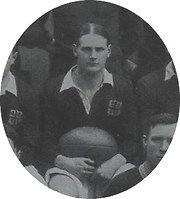 Created by Unknown
Donated by Peter S Chapman
Created by Unknown
Donated by Peter S ChapmanPart of the A Tyneside Heritage collection
Dated 1914
Born in Cleadon in 1888, Freddie Chapman, studied medicine at the College of Medicine, Durham University and played Rugby for his home club of Westoe. He played for his Club on that wing and with Durham County and England and was on 1908 British Lions tour in Australia and New Zealand.
That year he also played for an Anglo-Welsh XV against the touring Australians. He played for England whilst a Westoe player in all four 1910 Internationals, one of which, England v Wales marked the opening of the stadium at Twickenham, Chapman has the distinction of being the first player to score a try, conversion and penalty on this famed ground, the win over Wales being the first win by England against the Welsh for 14 seasons.
Joining Rovers in 1911 his career was dogged initially by injury but whilst with Rovers he went on to play a further 3 games for England and resumed his County career, but like all of his generation the Great War brought his Rugby to close but remarkably the last of his 31 appearance for Durham was against Yorkshire in the 1919 campaign.
Having served in the Royal Navy and R A M C during the War Freddie Chapman continued as a Doctor in town and as an Honorary Surgeon at Hartlepools Hospital. He died at his home in Cliff Terrace aged just 50 in 1938.
More detail » 1914 -Arthur James Dingle, 1891- 1915 Rovers, Durham, Barbarians, England
1914 -Arthur James Dingle, 1891- 1915 Rovers, Durham, Barbarians, England
|
More detail »
 1918 - 1945 - Durham County - The Inter-war years.
1918 - 1945 - Durham County - The Inter-war years.
Like the pre-Great War years, few images appear to have survived on the County XVs from the restart in 1919 even into the post War period. One highlight was the appearance of the County XV in the 1932 Final.
More detail »
 1931 - Carl Aarvold (West) & Cliff Harrison (Rovers) - England Internationals.
1931 - Carl Aarvold (West) & Cliff Harrison (Rovers) - England Internationals.
The 1931 Five Nations Championship featured a remarkable couple of events when two local players Carl D Aarvold (West) and Cliff Harrison (Rovers) featured in the Ireland and Scotland games that spring. Cliff Harrison made his debut in the Irish match having been named on the wing in place of Aarvold. A month later they were both named in the centre and wing respectively in the Calcutta match, Aarvold also being named as England Captain.
Carl Aarvold, who was born in West Hartlepool and attended Durham School and Emmanuel College Cambridge where he gained a Blue. His early career saw him play in the centre with West, Headingley, and Blackheath. With Durham County he played 22 times in all, which included the Captaincy. His England career saw him win 16 caps, six of the matches he played as Captain, and in addition he was a Barbarian, and toured Argentina in 1927 and Australia in 1930 with the British Lions.
Cliff Harrison was born in Hartlepool ,joining for Rovers from Brigade, he made 58 appearances for Durham County. He played in no less than 7 England trials and played in the Irish and Scots games of 1931, selected also against France he had to withdraw due to injury.
More detail » 1945 - 1958 -Durham County XVs - Starting again
1945 - 1958 -Durham County XVs - Starting again
Images from the restart of County Rugby involving local players from the restart in 1945, like the restart after the Great War, few images have been traced from these restart seasons and would be welcomed on the site.
More detail » 1959 - 1968 - The Jim Collard/Mike Weston Era
1959 - 1968 - The Jim Collard/Mike Weston Era
For almost a decade in the 1960’s Durham County XV revived memories of the Halcyon Era at the beginning of the 20th., Century when firstly under West player, Jim Collard's Captaincy (then with Headingley) later Mike Weston’s Captaincy, the County appeared in 4 National County Semi Finals and two Finals, sharing the Championship once.
The County XV finals record for the era reads:
1958/1959 – Semi Finalists lost to Gloucestershire at Gloucester
1959/1960 – Semi Finalists lost to Warwickshire at Coventry
1961/1962 – Semi Finalists lost to Hampshire at Bournemouth
1964/1965 – Finalists lost to Warwickshire at Hartlepool
1966/1967 – Shared Championship with Surrey a draw at Twickenham then a draw at Hartlepool.
1967/1968 - Semi Finalists lost to Middlesex at Richmond
The County XV were also North Division Champions in seasons 1958-59, 59-60, 61-62, 64-65, 66 – 67 and 67 – 68.
Unlike the “Halcyon” era, it was not all plane sailing for Weston’s XV, in season 60/61 they came home in Fourth, whilst in 63/64 and 65/66 they ended up in Fifth spot from the six placings!
In addition, a number of town players achieved higher playing honours with Tony Peart and John Dee from Rovers playing for England, John Dee also toured with the 1962 Lions and Terry Arthur from West also turning out for England. Terry Arthur also gained a Blue at Cambridge whilst Denny Jesson from Rovers achieved a similar honour with Oxford.
As with the previous era, games against the Southern Hemisphere sides also saw local players pitting their talents against the tourists for N E Counties with Wilf Woodward playing against the Australians in 1958 at Gosforth, Denny Jesson against the 1960 South Africans again at Gosforth, Tony Peart met up with the 1964 All Blacks at Harrogate and John Dee also played for N E Counties against the 1966 Australians. Plus John Dee and Tony Peart also toured with the Barbarians.
Another remarkable feature of the Durham players in this era was the number that played away from the County due to their careers but travelled to play for the side. Among the clubs listed in the various programmes are City of Derry, Bedford, Richmond, Blackheath, Coventry, Edinburgh Wanderers, Metropolitan Police, Rosslyn Park, Moseley, Fylde and Headingley.
More detail »
 1976 - Durham County Centennial Season
1976 - Durham County Centennial Season
The season of 1976 into 77, saw Durham County mark 100 years since its inception and over those years many Hartlepool people both on and off the field have served the game within the County. The Union was formed at Walton’s Hotel, in Sunderland but our only known town Club at that time did not attend but since then there has been a constant stream of players, administrators, referees, coaches, schoolteachers and supporters who have given outstanding service to the Durham County Union.
More detail » 1980 - 1994 - Durham County - Age Grade Rugby
1980 - 1994 - Durham County - Age Grade Rugby
Images from just a few of the many Age Grade XVs fielded seasonally by the County Union as part of the Development programme.
More detail » 1989-1994 - Durham County - National Champions Runners Up
1989-1994 - Durham County - National Champions Runners Up
Images from the period 1989-1994 which saw Durham County carry off the National County Championship in 89 and then runners up in 1994, both games taking place on Twickenham as the modern wrap around Stadium was being developed.
More detail » 1997 - Durham County v Cumbria -
1997 - Durham County v Cumbria -
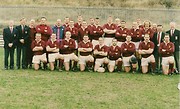 Created by Unknown
Donated by Stuart Bennett
Created by Unknown
Donated by Stuart BennettPart of the Stuart Bennett collection
Dated 1997
An image from the upheavals in the game following the 1995 decision to go open. Durham took on Cumbria at the New Friarage and came off second best to the tune of 66 points to 26. It is no surprise to recall that Cumbria came to the game as reigning County Champions.
More detail » 2007 - 2018 - Durham County - Carrying on, Carrying on.
2007 - 2018 - Durham County - Carrying on, Carrying on.
The rugby changes since the 1990s heralded a new phase for the Durham County XV which has witnessed them still bringing success to the County albeit at Plate and Division II levels of the Championship.
More detail » 2012 - Durham County under 15 v Northumberland.
2012 - Durham County under 15 v Northumberland.
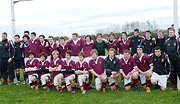 Created by J G Dove
Donated by J G Dove
Created by J G Dove
Donated by J G DovePart of the J G Dove collection
Dated 2012
The victorious Durham Under 15 squad which defeated Northumberland 29-19 on Sunday 28th February, 2012. at West Hartlepool TDSOB under Ben Wainwright’s coaching. If anyone can supply names/schools, please contact the website
More detail » 2019 - Durham County v North Midlands - Womens County Championship
2019 - Durham County v North Midlands - Womens County Championship
The growth of Women and Girls Rugby in recent seasons has been phenomenal, this season saw the Durham County XV play North Midlands (which covers Greater Birmingham, Herefordshire, Worcestershire and Shropshire) on the New Friarage with the Durham side home by 45 points to 12.
More detail » 2019 - Jason Leonard Under 20s Championship
2019 - Jason Leonard Under 20s Championship
Images frm the 2019 Under 20s Championship matches with games against Staffordshirew, Northumberland, Oxfordshire and then Surrey at Blaydon.
More detail »




